20 Epic Hikes in Chile: From Patagonia to the Atacama Desert

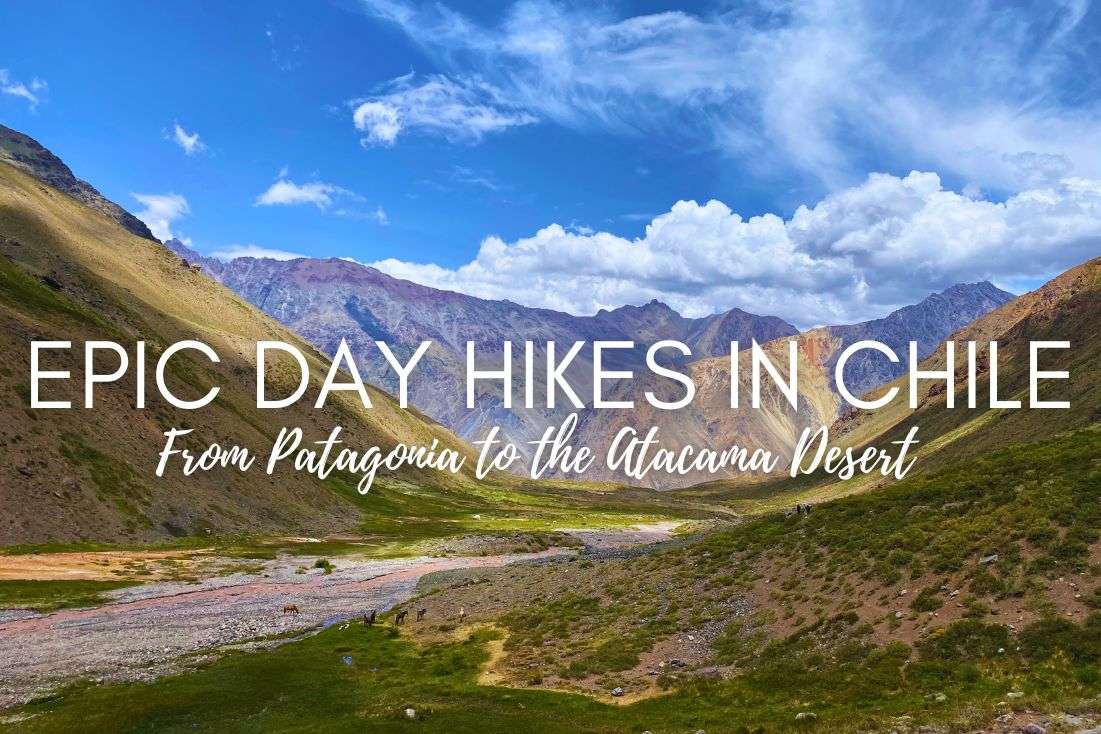
These are the top hiking trails in Chile, South America
Overview of Chile's hiking regions: From glacial lakes in Patagonia to trekking in the desert
My top tips for hiking in Chile:
What to pack for hiking in Chile
Top trekking tours across Chile's diverse regions
Hiking in Torres del Paine National Park, Chile (Patagonia hiking)
2. Mirador Base Las Torres Hike
5. Camp Grey—John Gardner Bridge Trek
Trekking in Pucón and Lake District
6. Villarrica Volcano Trek (Villarrica National Park)
7. Sendero Sierra Nevada Trek (Conguillío National Park)
8. Huerquehue Lakes Trail (Huerquehue National Park)
9. Sendero Los Alerces Loop Trail (Vicente Perez Rosales National Park)
10. Petrohué Waterfalls (Vicente Perez Rosales National Park)
11. Hike to Sargazo Lagoon (Allerce Andino National Park)
12. Salto Río Chaicas (Allerce Andino National Park)
Hiking and trekking in Santiago
The best hikes in the Atacama Desert
Chile is a promised land for all hikers—fairytale glens, challenging mountain peaks, crystal-clear lagoons, this country is packed with plenty of marvels of nature to appreciate. Learn more about Chile.
Over the course of my travels, I’ve hiked in nearly every corner of Chile, from the surreal landscapes of the Atacama Desert to the lush forests and volcanoes of the Lake District, and of course, the legendary Torres del Paine National Park in Patagonia. Torres del Paine, without a doubt, is the crown jewel for any hiker—it’s a place that lives up to the hype and then some. That said, the Lake District left a lasting impression, too, with Villarrica Volcano being one of the most intense and rewarding adventures of my life.
Let me be upfront—this list is all about day hikes (but I’ll throw in one multi-day hike for good measure). Why? Because I prefer hitting the trails during the day and returning to a cozy bed at night. Don’t get me wrong, when I’m out there, I’m giving it my all. But I like to mix it up on the trails. Some days I hit the trails hard, on others I’m happy with a less challenging walk.
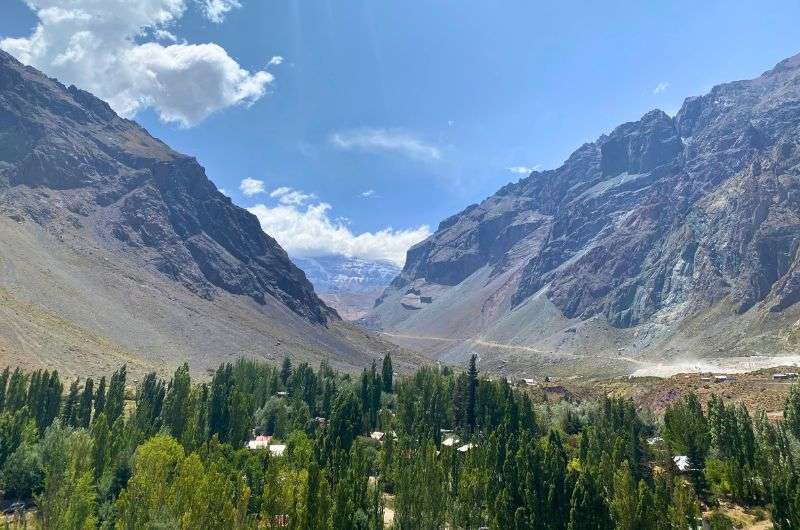
Chile has so many amazing hikes, I had to be picky to put together a list of 20!
Here are the 20 trails that stood out to me most across all of Chile’s best hiking regions:

These are the top hiking trails in Chile, South America
Torres del Paine National Park (Patagonia)
- W Circuit Trek
- Mirador Base Las Torres Hike
- Condor Lookout
- Cuernos Lookout Hike
- Camp Grey—John Gardner Bridge Trek
Lake District (Pucón)
- Villarrica Volcano Trek
- Sendero Sierra Nevada Trek (Conguillío National Park)
- Huerquehue Lakes Trail (Huerquehue National Park)
- Sendero Los Alerces Loop Trail (Vicente Pérez Rosales National Park)
- Petrohué Waterfalls (Vicente Pérez Rosales National Park)
- Hike to Sargazo Lagoon (Alerce Andino National Park)
- Salto Río Chaicas Trail (Alerce Andino National Park)
Santiago and surroundings
- San Cristóbal Hill
- Valparaíso City Circuit
- San Francisco Glacier Hike
- El Yeso Dam
Atacama Desert
- Moon Valley Trail
- Pukará de Quitor—Devil’s Throat
- Cerro Toco Trek
- Puritama Hot Springs and Puritama River Canyon
I’ve rounded up the most interesting and thrilling day hikes in Chile, with something for everyone—whether you’re after a challenge or a more casual stroll with the family.
Read on for detailed info on the top hiking trails with maps, insider tips, and more to inspire your next adventure.
Sometimes, all you need to do is take the first step... I've filtered out the best hotels in Chile for you
Save it for yourself to come back to later, or share with your friends on social media!
I've already planned your ititnerary for the trip, complete with my travel tips.
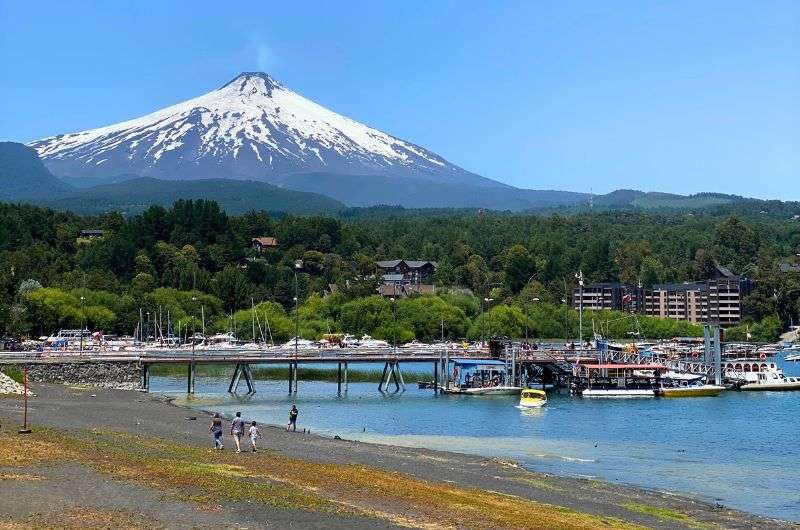
Pucón
Overview of Chile's hiking regions: From glacial lakes in Patagonia to trekking in the desert
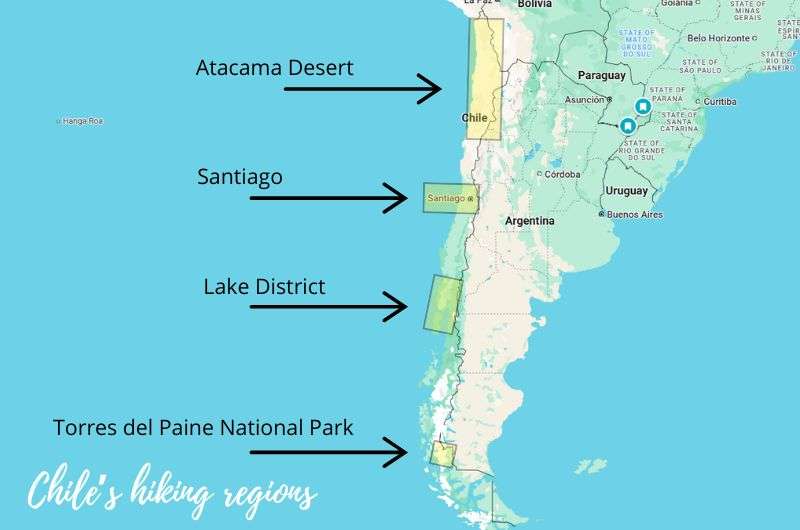
Chile is a loooong country, and the best hiking regions are spread out from top to bottom
Chile is an absolute goldmine for hikers, and the sheer variety of landscapes here is mind-blowing. Stretching over 4,300 km (2,670 mi) from north to south, this country has it all—whether you’re into arid deserts, lush forests, or rugged mountain peaks.
Let me walk you through the key regions where you’ll find the best trails:
- Torres del Paine National Park, Patagonia: This is Patagonia at its absolute best. Torres del Paine is famous for a reason—jaw-dropping peaks, glaciers that seem to go on forever, and trails that will test your limits. If there’s one place in Chile you can’t skip, it’s this.
- The Lake District: If you’re a sucker for postcard-perfect scenery, this is your spot. Think sparkling lakes, dense forests, and snow-capped volcanoes. The trails here are a little less intense, making it a great place to slow down and soak in the beauty.
- Santiago and surroundings: Sure, Santiago is a busy city, but head just outside of town, and you’re greeted by towering mountains and pristine trails. This region has a bit of everything, from casual urban strolls with killer views to glacier hikes that’ll leave you speechless.
- The Atacama Desert: Imagine vast salt flats, bizarre rock formations, and colorful valleys that look like they belong on another planet. Hiking here isn’t just about the views (though they’re incredible)—it’s about experiencing one of the driest, most surreal places on Earth.
Each of these regions has its own vibe and challenges, and whether you’re a seasoned trekker or just someone who loves the outdoors, there’s a hike here with your name on it.
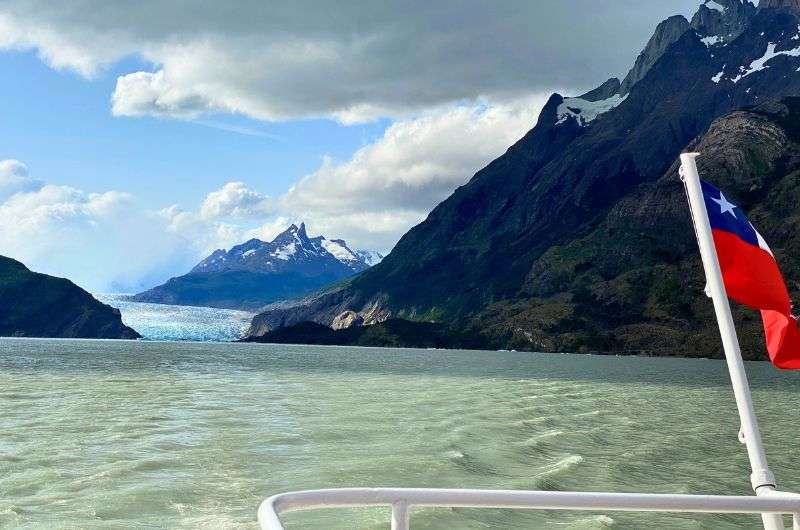
Cruising around the glaciers of Patagonia
My top tips for hiking in Chile:
- Always carry plenty of water and some cash. Many trails lack refreshment options, and most national parks only accept cash for admission.
- Don’t hesitate to ask the park rangers for advice. They’re super friendly, knowledgeable, and happy to help with tips or trail updates.
- Be prepared for all kinds of weather. Chile’s climate varies dramatically from north to south, so pack appropriate clothing for the region and season.
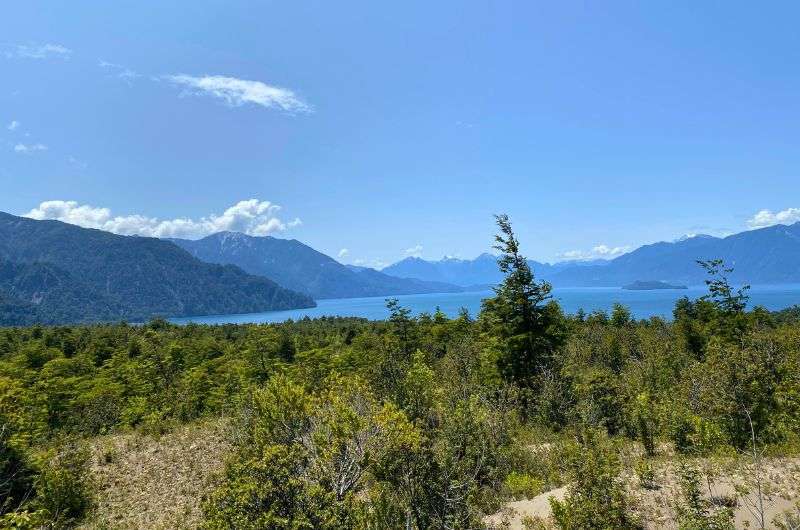
The beautiful Lake District scenery is interrupted only by the pesky horseflies
Best time for hiking in Chile
The best time to hike in Chile depends on the region you’re going to, as the country's long, narrow shape brings vastly different climates. Planning your hike during the peak season ensures better weather but may mean larger crowds on popular trails.
Here's a quick guide to help you plan:
- Torres del Paine National Park, Patagonia:
- Best time: November–March (summer).
- Avoid: April–October, as winter brings snow and strong winds, making trails more challenging or closed.
- Lakes District:
- Best time: October–April (spring to fall).
- Avoid: January, unless you’re ready to battle swarms of biting horseflies (tabanos). Winter hiking is possible but can be wet and muddy.
- Santiago and surroundings:
- Best time: September–May (spring to early fall).
- Avoid: June–August, as winter may bring snow to higher elevations, making some trails inaccessible.
- Atacama Desert:
- Best time: March–November (cooler months).
- Avoid: December–February, as summer can bring intense heat during the day. Mornings and evenings are ideal for hiking year-round.
Chile’s geography means there’s always somewhere great to hike, no matter the season. If you do your research ahead of time, you’ll have a fantastic hiking experience. Just make sure to pack appropriately for the region's unique weather conditions.
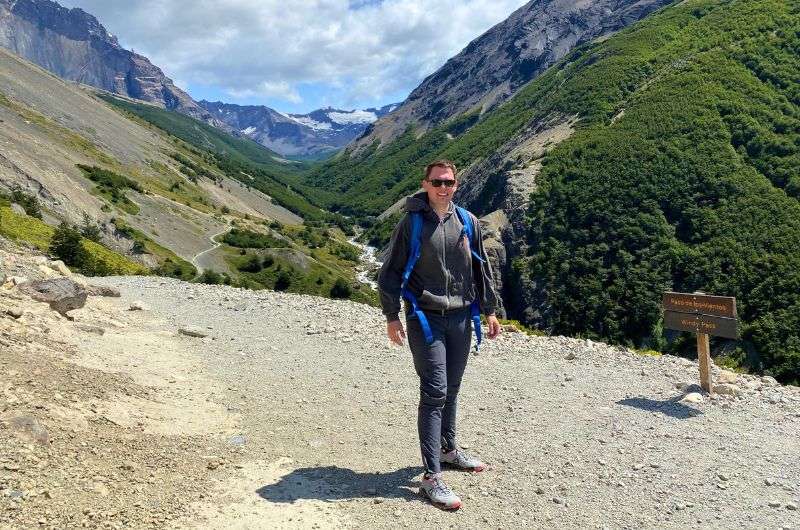
Ready to hike it all
What to pack for hiking in Chile
Packing smart is key to enjoying Chile’s trails. While you don’t need camping equipment for these day hikes, here’s what you should bring:
- Comfortable hiking boots: Sturdy and broken in, especially for rocky or uneven trails.
- Hiking poles: They can help stabilize you on rocky trails or uneven terrain.
- Layered clothing: Chile’s weather can change quickly. Pack moisture-wicking shirts, a warm layer, and a waterproof jacket.
- Sun protection: Hat, sunglasses, and sunscreen—essential, especially in the Atacama and high-altitude areas.
- Backpack: A small daypack for carrying your essentials.
- Plenty of water: Many trails don’t have refill stations, so bring enough to last the entire hike.
- Snacks: Energy bars, nuts, or fruit for an energy boost along the way. Always take enough food on the trails.
- First aid kit: Basic supplies for blisters, scrapes, or other minor injuries.
- Cash: Some national parks require an entrance fee, and many don’t accept cards.
- Camping gear: If you, unlike me, are planning to stay outside overnight, ensure you have proper camping gear to handle Chile’s variable weather.
Top trekking tours across Chile's diverse regions
I will now describe my favorite hikes in Chile, from Patagonia in the south all the way to the Atacama Desert in the north.
Hiking in Torres del Paine National Park, Chile (Patagonia hiking)
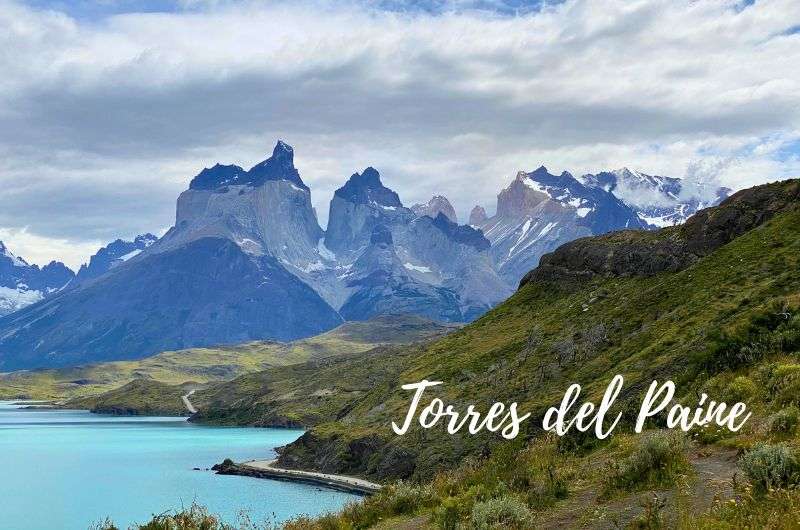
Torres del Paine, my favorite national park in Chile (and in all of Patagonia?)
The living, breathing heart of Chilean Patagonia is the Torres del Paine National Park. This is the place you must visit in Chile if nothing else. Torres del Paine offers some of the world's most iconic hikes, including the southernmost trek in South America.
For me, Torres del Paine is the most beautiful national park in Chile, and the best way to explore the area is hiking, but it’s not the only way! Learn more about the top things to do in Torres del Paine (Kayaking? Boat excursions? Ice walks?).
- Accommodation: Hotel Vendaval
Entrance fees
The entrance fees to Torres del Paine National Park in 2024 are:
- Ticket for up to 3 days: CLP 31,200 CLP (USD 33) for adults 18+, CLP 16,000 (USD 17) for children 12+
- Ticket for more than 3 days: CLP 44,500 CLP (USD 47) for both adults and children 12 years and older
Tickets to Torres del Paine must be bought online on CONAF’s official website.

1. W Circuit Trek
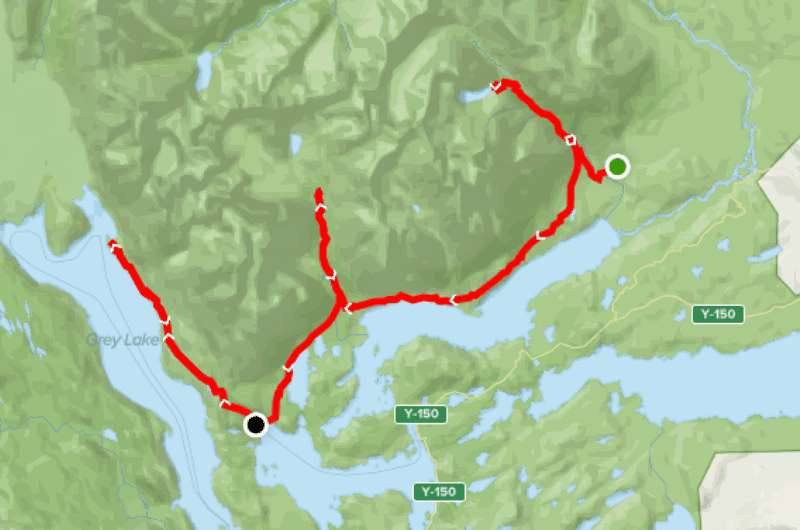
W Circuit Trek, named for its shape
- Difficulty: Hard
- Distance: 69.5 km (43 mi)
- Trailhead: Hotel Las Torres
- Parkng: at the hotel
- Elevation gain: 2 730 m (8 957 ft)
- Time: 4–5 days
The most famous hike in Torres del Paine National Park is the W Circuit Trek. It’s a multiday trek that includes all the highlights of the park: Las Torres, Los Cuernos, Francés Valley, Paine Grande, and Grey Glacier. The trek duration varies depending on your pace, typically taking four to five days to complete.
The best time to hike is from November to March when it’s summertime. The wind is omnipresent, but the weather will be more lenient in the summers.
Full disclosure: I’m more of a day hike kinda guy, so I haven’t done the full W Circuit. I’ve done the initial part of it to the famous towers, and I’ll describe that hike in the next item on this list.
What makes it unique
- The W Circuit in Torres del Paine National Park is a bucket-list trek, showcasing some of Patagonia's most jaw-dropping landscapes.
- Over 4 or 5 days (depending on your stamina), you'll traverse diverse terrains—from expansive valleys to rugged mountains—including breathtaking views of the iconic Torres del Paine towers.
- The trail is well-marked but varies in maintenance.
What to expect on the trail
The W Circuit is a rollercoaster of jaw-dropping views and mixed terrain. The trail is well-marked but far from a cakewalk—expect forest paths, rocky climbs, and sections that’ll test your patience (and your legs).
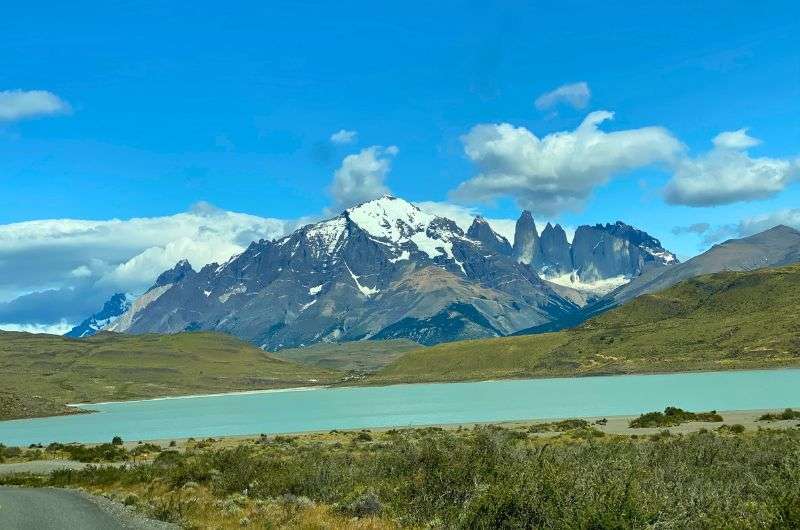
Have I mentioned the marvellous views in Torres del Paine?
Day 1 sets the tone, starting with glacial rivers and lush forests before a climb to the Chileno campsite, where you’ll feel both accomplished and ready to collapse.
Day 2 ramps things up with the Valle del Francés, and you’ll probably hear avalanches in the distance around Mirador del Francés—chilling, but in the best way.
By Day 4, you’re in Glacier Grey territory, where the icy-blue expanse will have you staring slack-jawed for longer than you’ll admit. The trek ends with a hike back to Paine Grande and a ferry ride across Lago Pehoé, which feels like the cherry on top of an exhausting, incredible adventure.
Practical info: Layers are your best friend—Patagonian weather doesn’t play nice, and you’ll get all four seasons in one day. Hiking poles are less for the walking and more for steadying yourself when the wind decides to make you its plaything. Campsites are basic but do the job, and if you’ve booked a hut, you’ll feel like royalty.
2. Mirador Base Las Torres Hike
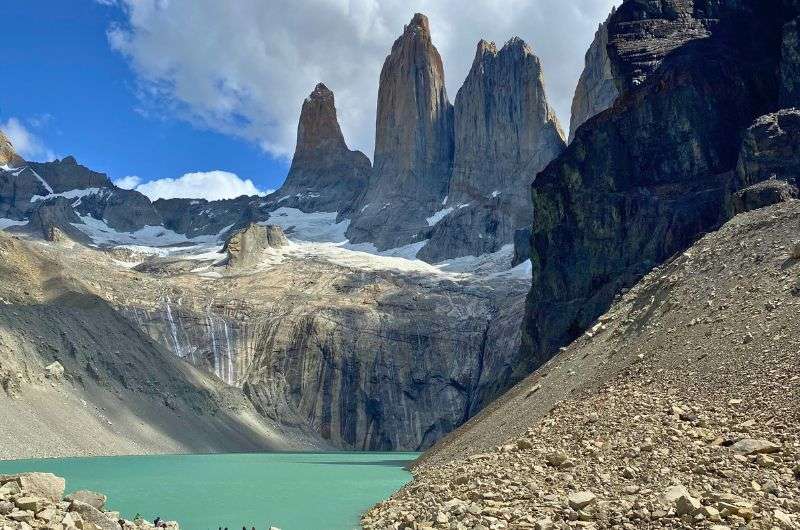
The iconic views of the 3 peaks that gave the park its name
- Difficulty: Hard
- Distance: 17.4 km (11 mi)
- Trailhead: Hotel Las Torres
- Parkng: at the hotel
- Elevation gain: 990 m (3 248 ft)
- Time: up to 10 hours
This is THE hike you have to do in Chile—the one that takes you to the legendary Torres del Paine peaks. It starts in front of Hotel Las Torres like the W Circuit Trek as it’s technically the initial part of it.
What makes it unique
- The end of the trail is what you’re here for—three towering granite peaks shooting up to nearly 3,000 m (9,500 ft) above sea level behind a bright turquoise lake. It’s the kind of view that will leave you completely stunned. The hike is a grind, but the end makes you forget all about your tired legs.
- These spires, once called the “Cleopatra Needles,” are the park’s namesake and an absolute bucket-list moment for any hiker.
What to expect on the trail
The trail starts at Hotel Las Torres and doesn’t waste time—it’s uphill pretty much immediately. I’ll be honest: the first part of the hike is nothing to write home about, with decent views but nothing jaw-dropping. Stick with it, though, because the payoff is worth every step.
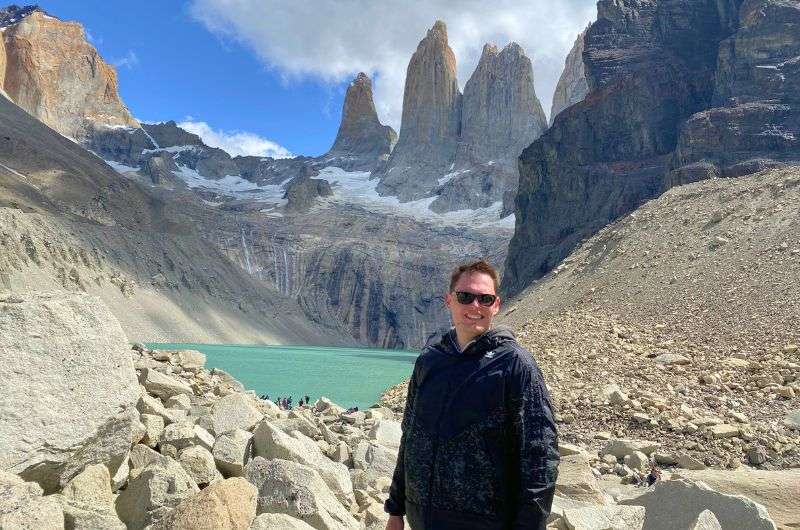
And here’s proof I really did conquer it! And it was amazing
After 4–5 hours of hiking, depending on your pace, you’ll reach the iconic lake at the base of the towers.
And wow, when those three spires come into view, it’s a brain-melting moment. Standing at 850 m (2,788 ft) at the lake’s edge, you’ll be staring up at a 2,000-m (6,500-ft) vertical wall of granite. It’s the kind of view that makes you stop, stare, and babble incoherently because your brain just can’t handle the scale. I just stood there speachless.
Pro tip: Start early to avoid the crowds at the viewpoint, and bring layers—the weather here changes faster than you can say “Torres del Paine.”
3. Condor Lookout
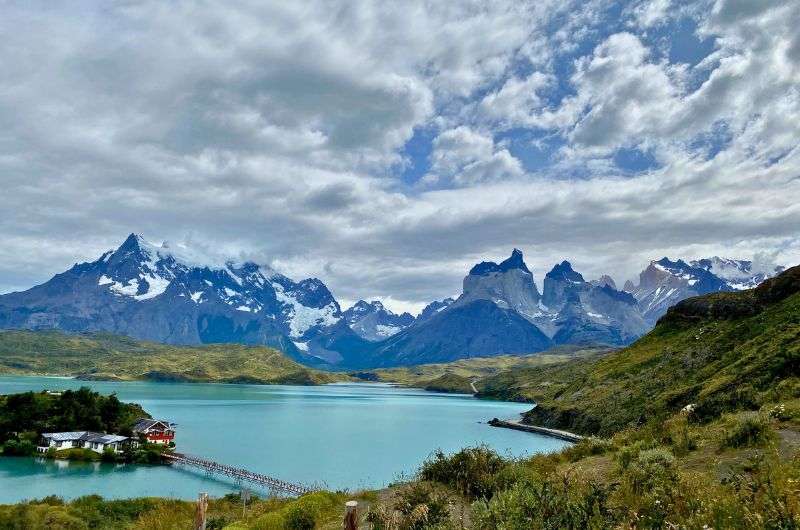
Condor Lookout
- Difficulty: Easy
- Distance: 2.3 km (1.5 mi)
- Trailhead: close to Camp Lago Pehoe
- Parking: there are some parking spots by the side of the road, or scout out around the camp, it’s easy to find a spot
- Elevation gain: 189 m (620 ft)
- Time: 1 hour
This hike may be short, but the scenery packs a serious punch. The Condor Lookout offers magnificent 360° views of Lake Pehoé and the Los Cuernos peaks.
It is a bit steep in the beginning, but you rarely get such stunning views for free, am I right? Despite what every guidebook about Patagonia says, I had beautiful sunny weather, so I enjoyed the views to the fullest.
What makes it unique
- Condor Lookout is the perfect “easy hike” in Torres del Paine, offering 360° views of Lake Pehoé, the dramatic Los Cuernos peaks, and even the Southern Patagonia Icefield—a massive remnant from the last Ice Age.
- It’s named for the Andean condors that nest just below the rocky viewpoint, so you might spot these giant birds soaring right overhead while you enjoy the view.
What to expect on the trail
The trail is short but steep, climbing steadily the entire way up to the viewpoint. It’s not grueling, but your legs might complain a little.
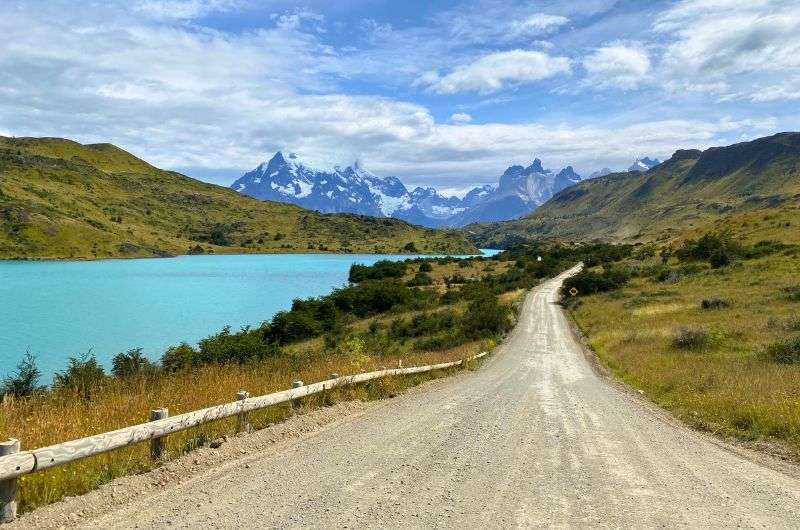
Driving to Torres del Paine
This is Patagonia, though—no epic views come without any work at all! The payoff at the top is worth it: endless vistas of Lake Pehoé’s blue-green water, jagged peaks, and the sprawling Southern Patagonia Icefield in the distance. A huge ice plain that remained from the last Ice Age.
We had sunny weather, so we could actually see and hear the rumble of the ice cracking and falling in parts. Now that’s an exciting experience. And yes, you’ll find yourself instinctively checking the ground beneath your feet just in case!
Pro tip: Keep an eye out for condors, which often soar gracefully over the cliffs.
4. Cuerno Lookout Hike
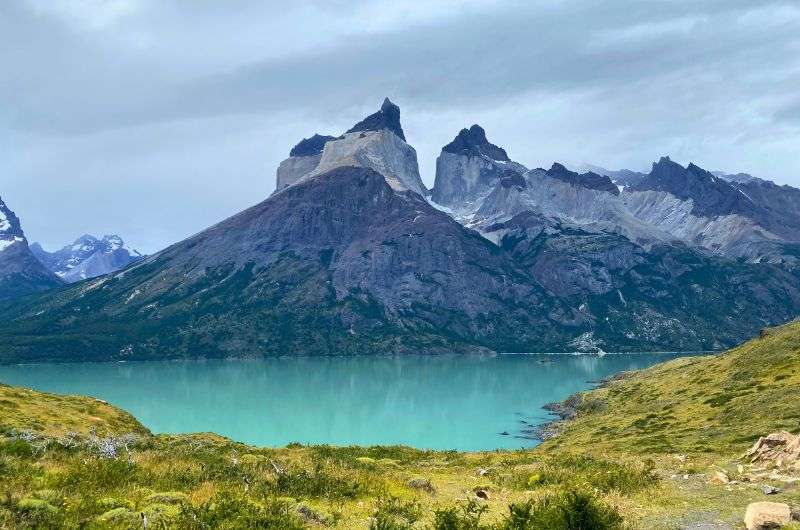
The Cuerno Lookout
- Difficulty: Easy
- Distance: 6.3 km (4 mi) out-and-back
- Trailhead: -51.064570, -72.997102
- Parking: you can leave your car at the starting point
- Elevation gain: 179 m (587 ft)
- Time: 2 hours
You know how I said you can’t get amazing views for free? Well, this hike comes close.
Only a little bit further up the road from Condor Lookout is the Cuerno Lookout, a truly spectacular hike that offers breathtaking views of the Salto Grande Waterfall. The trail is short and almost flat.
What makes it unique
- The Cuernos Lookout trail gives you Patagonia’s epic views with minimal effort—think dramatic waterfalls, shimmering lakes, and the iconic Cuernos del Paine peaks all in one short hike.
- It’s quieter than other trails in Torres del Paine, making it a great escape from the crowds while still delivering jaw-dropping scenery.
- The highlight is Salto Grande Waterfall, where the waters of Lake Nordenskjöld crash into Lake Pehoé with thunderous energy.
What to expect on the trail
This 6.4 km (4 mi) out-and-back trail starts at a trailhead with convenient parking, so no long approaches here. The path is relatively flat with only gentle ups and downs—enough to keep things interesting but easy enough for hikers of all levels.
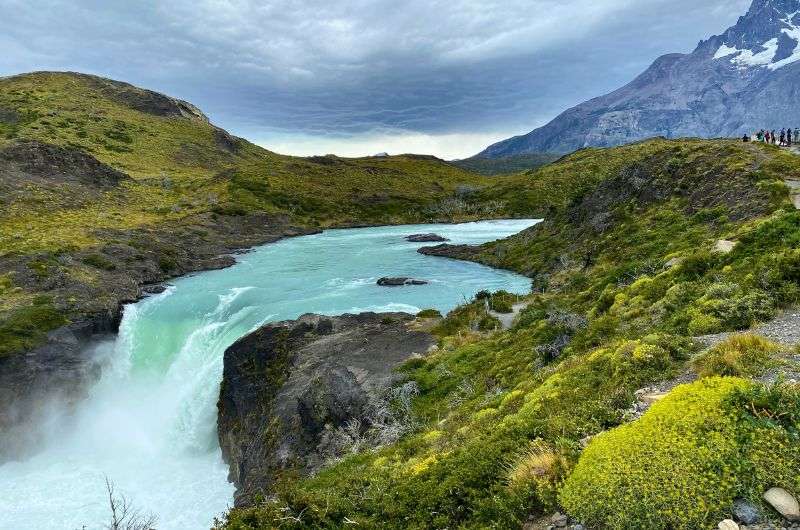
Salto Grande Waterfall
Just a few minutes in, you’ll hit the Salto Grande Waterfall, a roaring cascade that connects two of Torres del Paine’s iconic glacial lakes. It’s mesmerizing to watch.
From there, the trail opens up with sweeping views of Lake Nordenskjöld, framed by the jagged Cordillera del Paine and the French Valley in the distance. The final viewpoint brings you face-to-face with the Cuernos del Paine (Horns of Paine)—dark granite peaks with white tops that look like they’ve been carved by giants.
This trail is a quieter alternative to some of the park’s busier routes, and the peaceful vibe is part of what makes it special. If you’re lucky, you might spot guanacos or even catch a rainbow over the lakes if the weather cooperates!
Pro tip: Combine this hike with the nearby Condor Lookout for a perfect half-day trip. It’s low effort, high reward, and one of the easiest ways to take in Torres del Paine’s signature beauty.
5. Camp Grey—John Gardner Bridge Trek
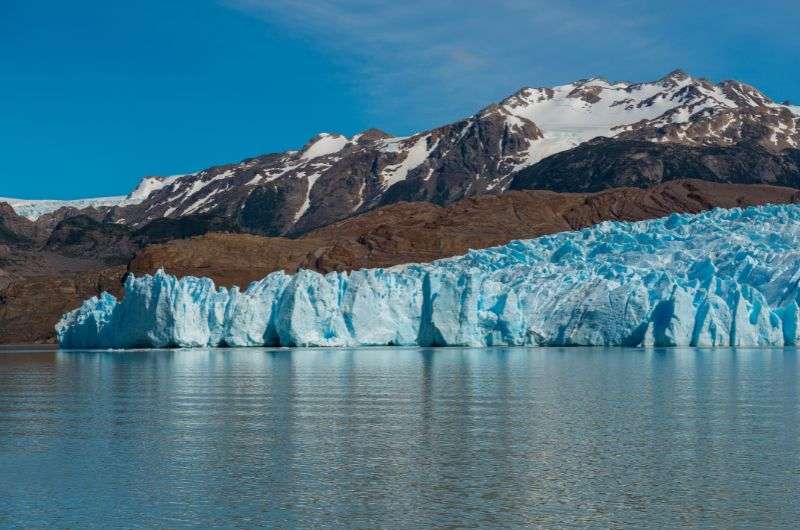
Glacier Grey
- Difficulty: Medium
- Distance: 9.3 km (5.7 mi)
- Trailhead: Refugio Grey
- Parking: park at the refugio
- Elevation gain: 373 m (1 223 ft)
- Time: 3 hours
And finally, you can’t miss out on the trek to Glacier Grey. How many times in your life will you get the chance to walk around a massive glacier? On this journey, you get to marvel at the raw beauty of Lake Grey with floating chunks of ice from the glacier. If you’re lucky, you can even spot the condors circling above the lake.
Pro tip: This hike is not as hard as some of the others on this list, but I do not recommend this to people that are afraid of heights as there are three suspension bridges on the way.
Pro tip: You can see Grey Glacier without the slog, too—how does kayaing right up close to it sound? Or just taking a boat cruise? I’ve described both options in a separate article: Learn about the adventure activities in Torres del Paine
What makes it unique
- Glacier Grey is a must-see in Torres del Paine. Walking alongside a massive, shimmering glacier is simply unreal. Plus, you’ll get thrilling suspension bridge crossings that deliver adrenaline and panoramic glacier views in one shot.
- The floating ice chunks in Lake Grey are mesmerizing—they look like mini glaciers taking a vacation.
What to expect on the trail
The hike starts at Refugio Grey, which you’ll reach via a ferry ride across Lake Grey (and yes, the ferry itself is a treat with killer views).
The trail kicks off pretty gently through the forest, but it doesn’t stay that way. Before long, you’re climbing rocky paths with steep sections that’ll remind you why you packed those sturdy hiking boots.
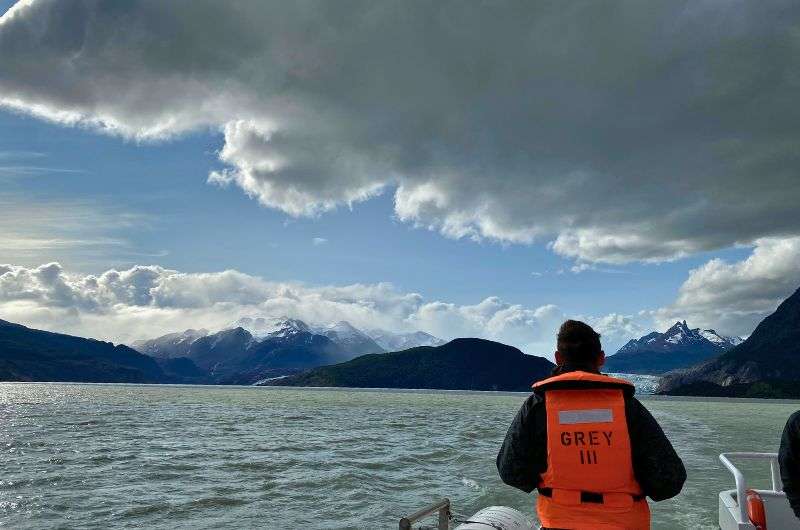
Heading towards Glacier Grey
Then come the suspension bridges—three of them. They’re long, a bit wobbly, and high enough to give anyone with a fear of heights second thoughts. But the views are worth every shaky step. From the bridges, you’ll get insane angles of Glacier Grey that you can’t see anywhere else.
Pro tip: The consensus seems to be that the views from the 2nd bridge are the best, so if you want to shorten the trail, you can turn back once you reach it.
The trail is well-marked, but the rocky terrain can slow you down. At times, it feels like the glacier is right there with you, its icy-blue expanse stretching endlessly. The sound of ice breaking and crashing into the lake adds to the drama, and yes, you’ll keep glancing nervously at the ground beneath your feet—don’t worry, it’s solid.
Heads up, the boat tickets, like everything else in Torres del Paine, are pricey. But totally worth it. The ferry operates daily, but the times of the navigations vary according to season.

Trekking in Pucón and Lake District
Here we go, Chilean Lake District is arguably the best location in Chile for hiking. Base yourself in Pucón and off you go!
There are countless national parks with awesome views and well-marked trails.
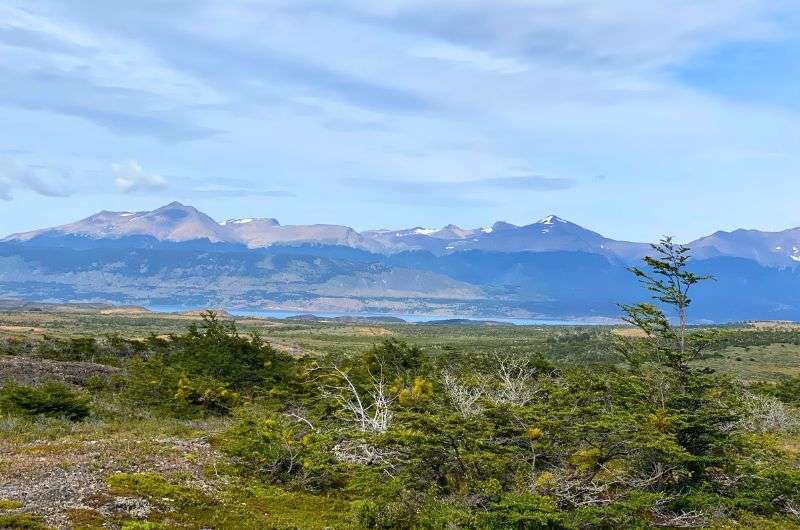
Chile is full of wonderful nature
Pro tip: Don’t plan this region for January, unless you want to be eaten alive by a huge flying blood-sucking helicopter. I mean horsefly. They are relentless! And remember, beyond trekking, the Lake District offers other activities like whitewater rafting, perfect for adrenaline seekers. More details in my article about the best of Lake District Chile.
- Hotel recommendation: Hotel Cumbres
6. Villarrica Volcano Trek (Villarrica National Park)
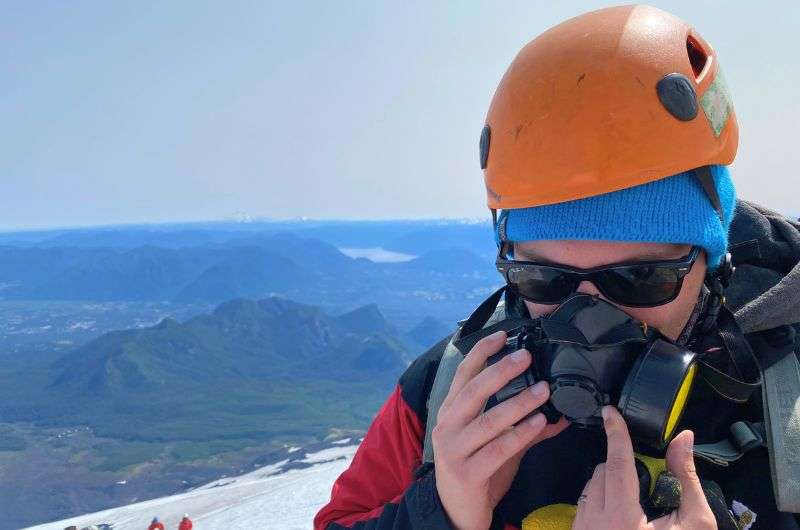
Villarica gave me a hard time, but I still loved it!
- Difficulty: Hard (mountaineering and climbing skills convenient)
- Distance: Only 3 km (1.8 mi), but you’ll feel them!
- Trailhead: usually at the Villarica Refuge
- Parking: you will probably arrive by bus with your tour group, so no need to park at the Refuge parking lot
- Elevation gain: 1,500 m (4,921 ft)
- Time: min. 3 hours up, 1.5 hours down
More of a climb than a hike, but I couldn’t possibly leave this out of the list. Chile has countless volcanos, but the experience at Villarrica is unforgettable!
The Villarrica ascent is really demanding and difficult, so think twice before you decide to take it on. On the other hand, it was one of the most adrenaline-packed and rewarding experiences of my life.
Pro tip: It is necessary to book a tour guide as it could be life-threatening to go on your own.

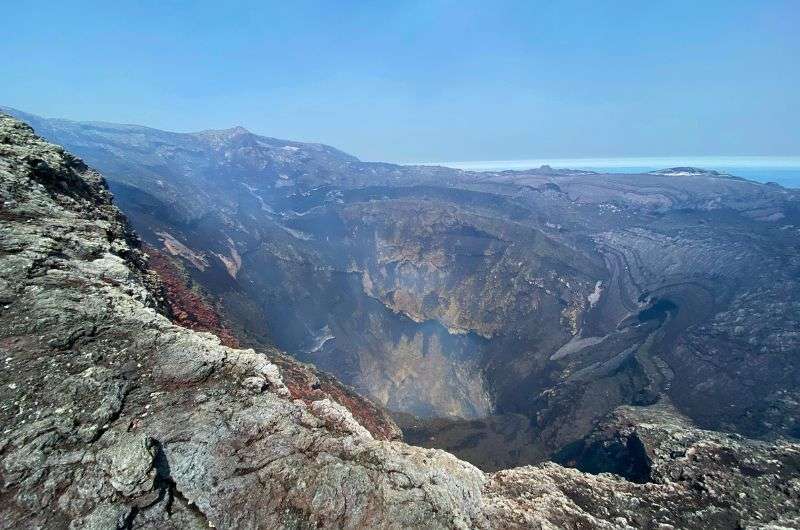
It's not every day you get to stand at the edge of an active volcano
What makes it unique
- Villarrica is the most active volcano in South America and the crown jewel of Villarrica National Park.
- It’s a wild mix of adrenaline and awe: climbing through ancient lava flows and glaciers, all while carrying an ice axe, crampons, and (oh yeah) a gas mask for the sulfur fumes near the top.
- I’ll never forget feeling the warm ground near the crater, and if you’re lucky, you’ll glimpse bubbling lava just below the surface, too. Oh, and you get to sled down the volcano on the way back. Hike goals? Achieved.
What to expect on the trail
The day starts early with a 7 am meet-up in front of the tour agency, where you’ll get your gear—ice axes, crampons, helmets, and gas masks. Yes, you’ll need it all.
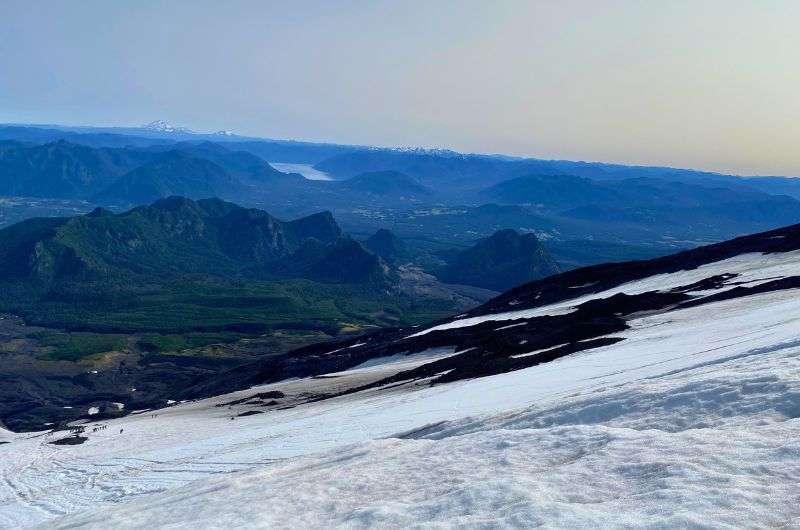
The incline is insane (but it makes for a fun slide down!)
From the starting point at 1,500 m (4,921 ft), the climb wastes no time getting serious. The trail zigzags up steep volcanic rock before hitting the glacier section. You’ll spend the next chunk of the climb stomping your crampons into the ice at what feels like a 45° angle, praying your feet don’t slip. Our guide was great, so I never felt at danger (too much).
The altitude and sulfur fumes start messing with your lungs near the top, and that’s where the gas mask comes in. But the surreal sight of the crater makes it all worth it—warm ground, thick fumes swirling around you, and if you’re lucky, the sight of lava… totally insane!
Then comes the second-best part: the descent. Instead of hiking down for hours, you’ll slide down the glacier on a plastic sled, which is honestly as fun as it sounds. It’s bumpy, fast, and a little ridiculous—but after the brutal climb, you’ll be too thrilled to care.
Tours start at around CLP 190,000 (USD 190) and include everything: gear, guides, and safety briefings.
7. Sendero Sierra Nevada Trek (Conguillío National Park)
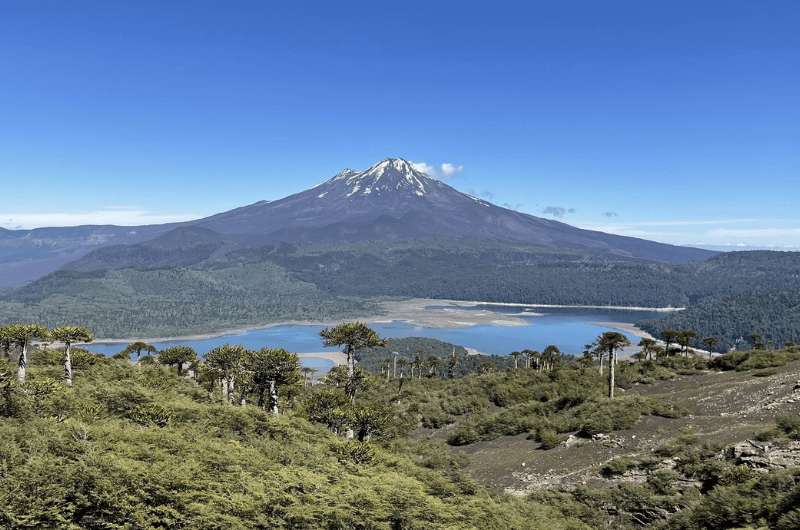
Sendero Sierra Nevada
- Difficulty: Medium
- Distance: 11.4 km (7 mi)
- Trailhead: -38.650430, -71.619633
- Parking: there are several parking spots at the starting point
- Elevation gain: 602 m (1,975 ft)
- Time: 4.5 hours
Conguillío National Park boasts numerous hiking trails, volcanic lagoons, ancient forests, and some rare species such as endemic Araucaria trees, or cordilleran Cypress. This hike hits that sweet spot: challenging enough to feel rewarding but not exhausting.
What makes it unique
- Conguillío National Park is a volcanic wonderland, with the towering Llaima Volcano, shimmering Conguillío Lake, and ancient Araucaria forests—trees so old they date back to the dinosaurs.
- The Sendero Sierra Nevada trail gives you the park’s best views, from volcanic landscapes to the dramatic Sierra Nevada mountain range.
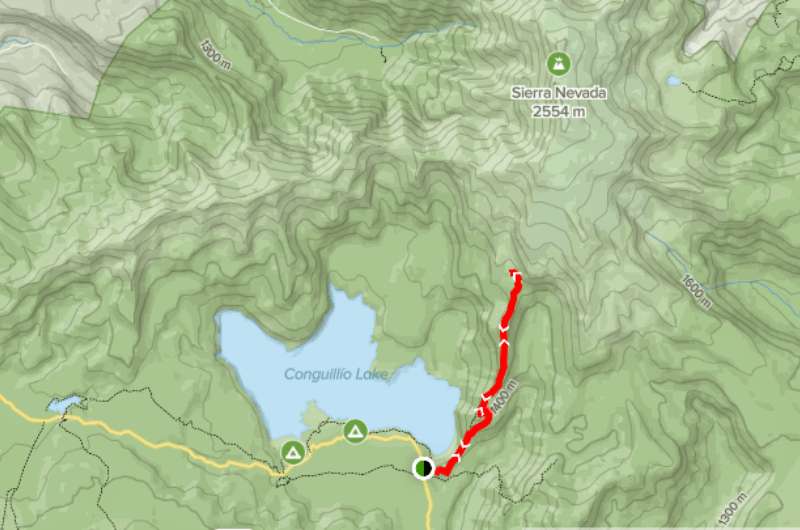
Sendero Sierra Nevada Trek from Alltrails.com
What to expect on the trail
The trail starts with an easy climb through towering Araucaria trees, where sunlight filters through the dense forest and you might spot a woodpecker or two. As you gain elevation, the views of Conguillío Lake and old lava flows spread out below—surreal and stunning. This is just such a beautiful trail.
A few steep switchbacks take you higher, where you’ll get jaw-dropping panoramas of Llaima Volcano and the Sierra Nevada peaks. The descent is easier, with more chances to admire the prehistoric forest and volcanic terrain.
There are other hikes that you should try in Conguillío National Park. Read about the best trails in Chile’s Lake District in another article.
8. Huerquehue Lakes Trail (Huerquehue National Park)
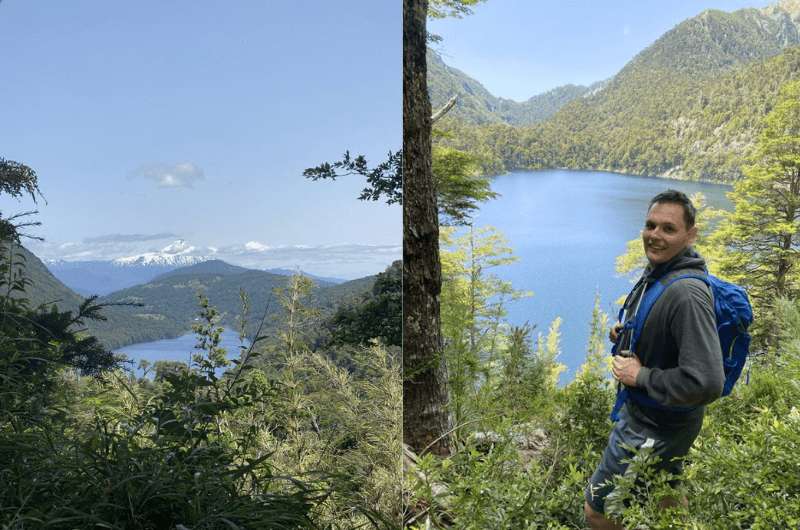
An experienced traveller in his natural habitat, discovering another national nature park. This time on the Huerquehue Lakes Trail
- Difficulty: Medium
- Distance: 10.5 km (6.5 mi)
- Trailhead: at the Kiosko La Pulguita
- Parking: parking available at the kiosk
- Elevation gain: 689 m (2 260 ft)
- Time: 5.5 hours
Huerquehue is one of the oldest national parks in Chile and the Lakes Trail sums up all the highlights of the park. I particularly enjoyed the part further up the trail with several lakes next to each other and every single one unique in its beauty.
What makes it unique
- Huerquehue National Park, established in 1912, is one of Chile’s oldest parks, and its Lakes Trail is the perfect way to experience its highlights without eating up your entire day.
- The trail winds past several lakes, each one more beautiful than the last, with reflections of ancient forests and snow-dusted peaks in their glassy surfaces.
- It’s a great mix of moderate effort and big rewards, perfect for a day hike in Chile’s Lake District.
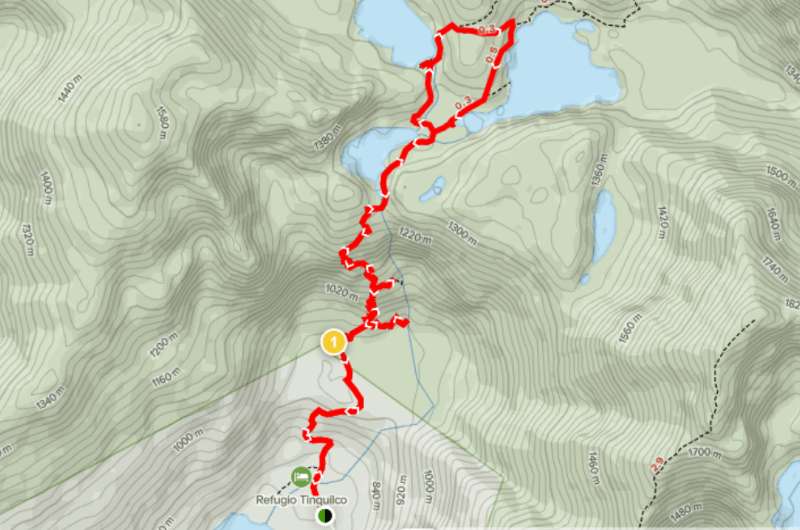
Huerquehue Lakes Trail
What to expect on the trail
The hike starts at Kiosko La Pulguita, where you’ll find easy parking before heading into the forest. The first stretch gets your blood pumping with steady inclines, but the dense forest of Araucaria trees and the occasional glimpse of waterfalls make it worth the effort.
Further up the trail is where the magic happens. You’ll come across a series of lakes—each one unique, with crystal-clear water and magnificent views. My favorite part was hopping between these lakes further along the route. You’d think that once you’ve seen a couple lakes, they’d all be the same, but no. Somehow each one has main character energy.
I finished the hike in about 4 hours, but if the weather’s wet, prepare for mud—lots of it—and more time spent hiking. The trail can get soggy, which slows things down and turns the route into a bit of an obstacle course.
Pro tip: Don’t rush. Pack snacks, soak in the views, and enjoy one of the Lake District’s most rewarding hikes. It’s a shorter version of the park’s main trail but still hits all the best bits.
9. Sendero Los Alerces Loop Trail (Vicente Perez Rosales National Park)
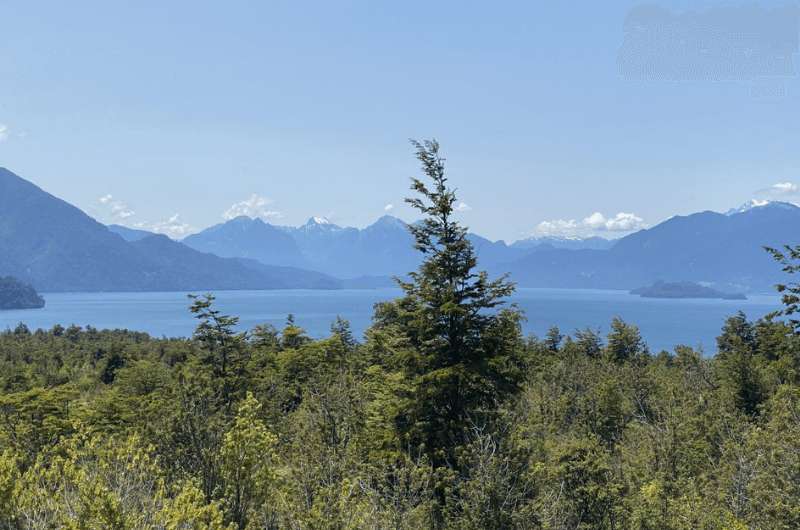
Sendero Los Alerces Loop Trail
- Difficulty: Medium
- Distance: 14.3 km (9 mi)
- Trailhead: the trailhead is at the campground in Petrohue
- Parking: plenty of parking in the area, you can try by the campground or at the nearby beach
- Elevation gain: 328 m (1,076 ft)
- Time: 4.5 hours
The Vicente Perez Rosales National Park stretches all the way to Argentina and it’s Chile’s first national park, established in 1926. It’s important mainly thanks to the transportation route to Argentina.
Below the slopes of Osorno volcano lies the Todos Los Santos Lake that makes a beautiful setting for a hike with views of Osorno. Too bad I didn’t know about the seasonal horseflies, so I had to wave my jacket above my head the whole way!
- Admission fee: CLP 7,000 (USD 7)
What makes it unique
- The Sendero Los Alerces Loop Trail in Vicente Perez Rosales National Park gives you a little bit of everything: ancient Alerce trees (Chile’s version of redwoods), views of Todos los Santos Lake, and the Osorno Volcano looming in the distance.
- It’s a solid hike if you want a mix of forest and open views, but be ready for some mud and a few sneaky inclines that’ll have you questioning your fitness halfway through.
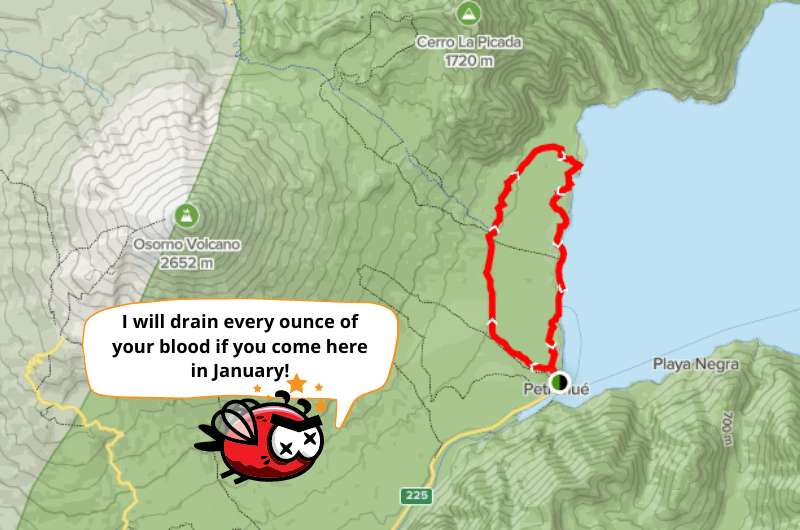
Really. I’m not exaggerating. Don’t go hiking in Chilean Lake District in January!
What to expect on the trail
The trail starts at the campground in Petrohue, where there’s plenty of parking—though if you arrive late, you might end up circling near the beach for a spot.
Pro tip: There is a paid parking lot towards the trailhead that you can happily pass and find free parking quite easily.
The first section takes you uphill into dense forest, and the Alerce trees are the stars here. These giants are seriously impressive, with thick trunks that’ll make you feel tiny.
About halfway in, the trail opens up to Todos los Santos Lake to the east, and the views are next-level (how fitting!). Along the way, there are several crossings of dry riverbeds, which can become torrents during heavy rain.
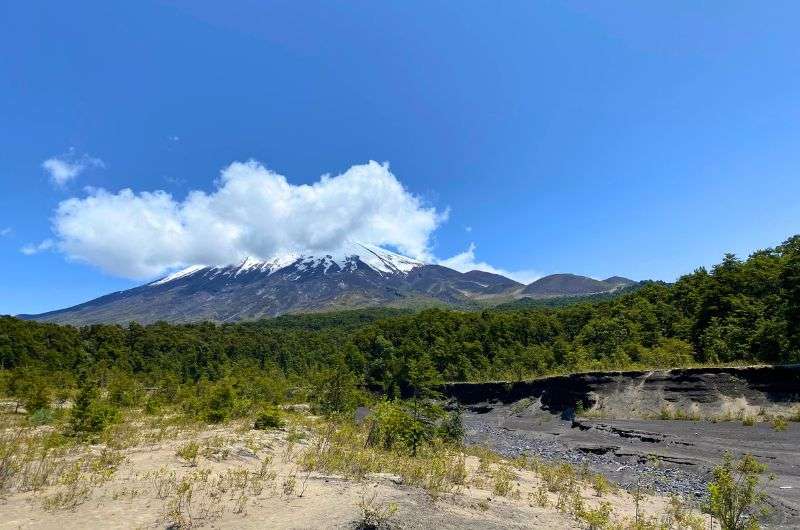
Osorno Volcano
You’ll get a clear shot of the Osorno Volcano, which looks like a kid’s drawing of a volcano—perfectly conical, snow-capped, and ridiculously photogenic. This is a good place to stop before heading into the longer, hillier section.
The middle of the loop is a steady downhill that makes you wonder when the trail will level out again. If it rained recently, this part is a mud-fest.
The way back feels easier, with more forested stretches along the lake’s shore. By the time you loop back to the trailhead, you’ll be ready to sit down—but also glad you stuck it out.
Pro tip: Bring bug spray! Those horseflies!!
10. Petrohué Waterfalls (Vicente Perez Rosales National Park)
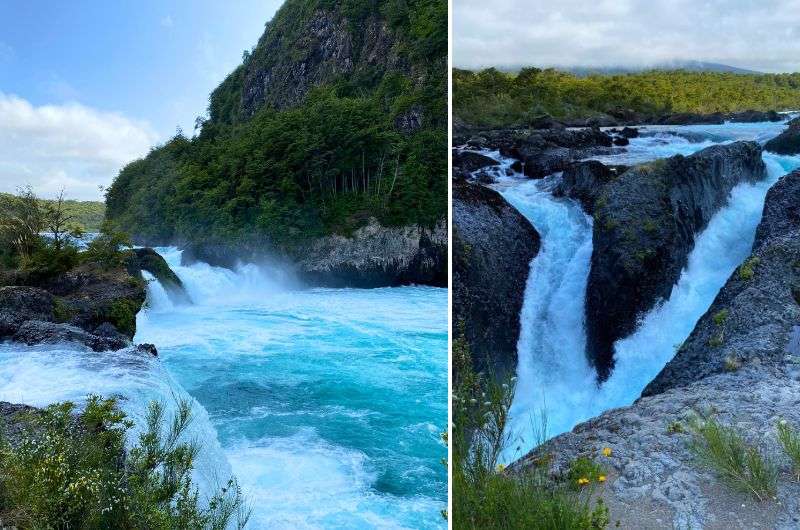
Petrohué Waterfalls
- Difficulty: Easy
- Distance: 1.8 km (1 mi)
- Trailhead: -41.173186, -72.451021 (by the tourist office)
- Parking: there’s a large parking lot with at the tourist office with free parking
- Elevation gain: 38 m (125 ft)
- Time: 2 hours
Petrohué surprised me—easily one of the best waterfalls I’ve seen, and I’ve seen plenty that didn’t deliver. The waterfalls are a part of the Saltos del Rio Petrohué Park located right next to the Osorno Volcano.
Admission fee: CLP 3,200 (USD 3.50)
What makes it unique
- Petrohué Waterfalls (Saltos del Petrohué) are bright turquoise torrents rushing over black volcanic rock, with the Osorno Volcano standing tall in the background.
- It’s one of Chile’s most famous natural spots, and for good reason. The contrast of water, rock, and volcano scenery is seriously impressive.
What to expect on the trail
The trail starts at the tourist office, where there’s a big parking lot (free). The walk itself is a super-easy, well-marked path that winds through a mix of trees and open areas.
You’ll hit a few viewpoints early on, where you can get up close to the roaring waterfalls and watch the water cutting through the volcanic basalt. The water is a ridiculous shade of blue-green—it almost doesn’t look real—and seeing it tumble over the jagged, dark rock with the Osorno Volcano in the background is a jaw-dropper.
The trail loops through more scenic spots, all short and manageable, so even non-hikers will love this one.
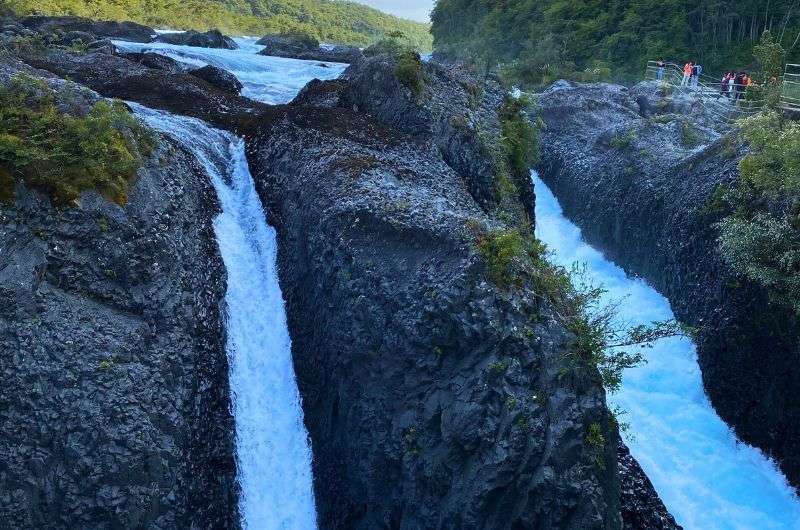
Petrohué Waterfalls were awesome!
I spent about two hours here wandering the paths and taking photos. Honestly, it’s worth lingering, especially if you’re not fighting off a crowd of selfie sticks (go early or late to avoid that nightmare).
The rocks around the falls can be slick, so wear sturdy shoes—the kind that won’t betray you in front of a crowd.
Pro tip: Pack a snack or water; there’s a small café near the parking lot, but it’s nothing special. And if you’re going for the photos, morning light is best to catch the colors at their brightest.
11. Hike to Sargazo Lagoon (Allerce Andino National Park)
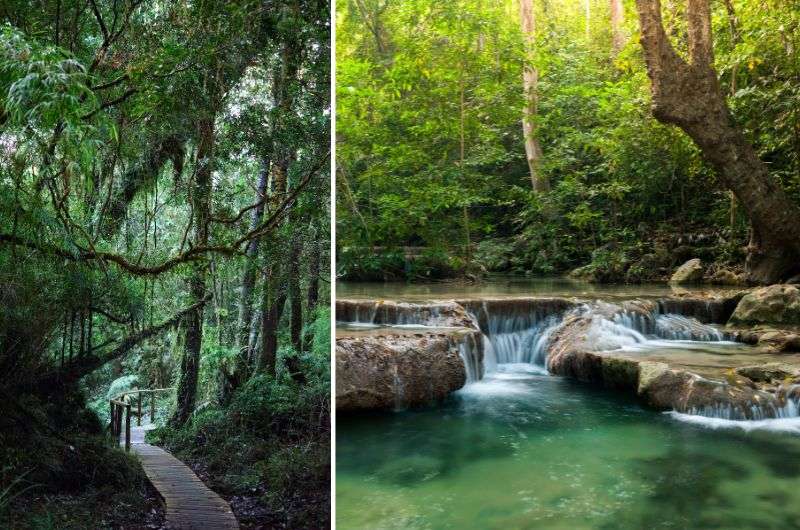
Hike through Allerce Andino National Park
- Difficulty: Easy
- Distance: 7 km (4.3 mi)
- Trailhead: -41.508549, -72.621209
- Parking: parking spots at the trailhead (there’s a little info booth there, too)
- Elevation gain: 358 m (1 175 ft)
- Time: 2.5 hours
Allerce Andino National Park is a hidden gem for hikers. It lies around an hour’s drive from Puerto Montt yet it’s overlooked by tourists. The hike to Sargazo Lagoon is super simple and suitable even for small children.
Walking through the forest on the wooden pathways you’ll feel like in the jungle until the spectacular view of the crystal-clear lake spreads out in front of you. Then, you will feel like Indiana Jones on his quest.
Admission fee: CLP 5,000 (USD 5)
What makes it unique
- Alerce Andino National Park is a quiet place, just an hour from Puerto Montt and free from tourist hordes.
- The Sargazo Lagoon hike is an easy, family-friendly trek through lush forests, leading to a stunning crystal-clear lagoon.
- Along the way, you’ll pass ancient Alerce trees, some nearly 3,000 years old.
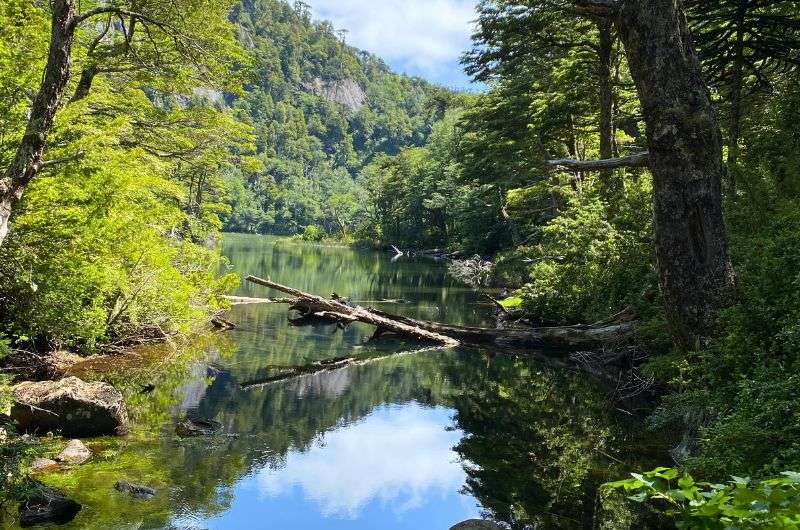
Sargazo Lagoon
What to expect on the trail
Right away, the path splits into two forks, both leading to the lagoon, but not connected to each other:
- Take the left fork if you want to walk past some truly massive Alerce trees. These ancient giants are humbling to stand next to and are one of the park’s biggest highlights. Beware that the trail isn’t very well maintained on this side.
- The right fork crosses a small river and gets you to the lagoon faster and on a path that is easier to hike on. If you only do one of the trails, make it this one.
The hike is short and well-marked, with wooden walkways in the muddier sections, but it’s not stroller-friendly due to some stairs and uneven spots. Wear sturdy shoes—the forest and the wooden walkways can be slippery.
When you reach the Sargazo Lagoon, the payoff is fantastic: a mirror-like lake surrounded by greenery. It’s the perfect spot to stop, take in the peace and quiet, and snap a few photos.
The hike is manageable for most people, even kids, but pack water and snacks since facilities are limited. And please—take your trash with you. It’s a beautiful, wild place, and it deserves to stay that way.
This hike is short, simple, and packed with natural beauty, making it one of the best hidden gems in Chile’s Lake District.
12. Salto Río Chaicas (Allerce Andino National Park)
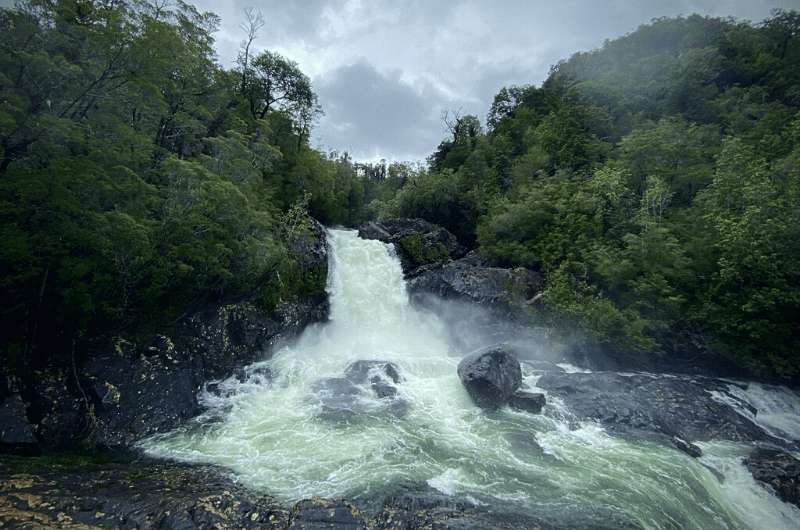
Salto Río Chaicas Trail
- Difficulty: Easy
- Distance: 7.6 km (4.7 mi) out-and-back (more if going to the lakes)
- Trailhead: -41.593492, -72.593465
- Parking: easy parking at the trailhead
- Elevation gain: 109 m (358 ft)
- Time: 2 hours
Same park, different part. The Salto Río Chaicas hike leads along the river on the well-maintained trail. It‘s low effort, high reward, and a great way to explore a quieter part of Alerce Andino National Park.
- Admission fee: CLP 5,000 CLP (USD 5), paid per person per day (if you manage to do more hikes in one day, you only pay once)
What makes it unique
- The Salto Río Chaicas Trail in Alerce Andino National Park is all about peaceful river views, lush forests, and charming waterfalls.
- You’ll follow the Chaicas River on an easy, well-maintained trail with plenty of spots to stop and soak it all in. Bonus: keep your eyes peeled for Andean foxes—they’ve been spotted here!
What to expect on the trail
The trail starts at a clearly marked trailhead with easy parking nearby—always a win. From there, it’s a straightforward path that hugs the river, winding through dense forest with occasional breaks where you can take in the water rushing over volcanic rock.
About halfway along, there’s a nice picnic area, complete with tables where you can stop for snacks or just chill for a bit.
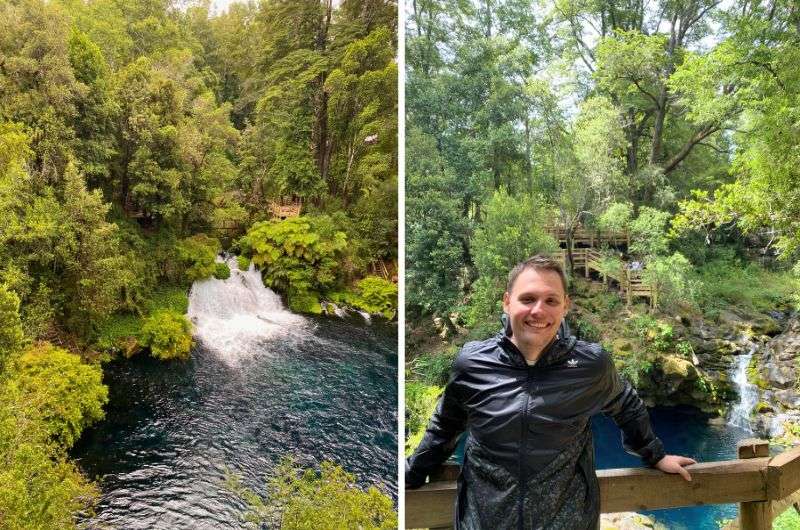
The waterfalls you will see on Salto Río Chaicas trail are truly spectacular
The trail has a few sections with rock scrambling and stairs, which keeps things interesting, but nothing too demanding. That said, it can get pretty muddy after rain, so wear sturdy shoes unless you enjoy an unplanned slip-and-slide adventure.
The waterfalls along the way are the real highlight, though—multiple cascades tumbling through the forest, each one prettier than the last. The trail is short and sweet, making it perfect if you’re looking for something relaxing but still scenic.
It seems like there’s an option to continue on further to hit up some lakes, but we ended our hike at the last waterfall. Check ahead if you’re planning to visit the lagoons—those paths are sometimes closed.
Pro tip: The park has strict entry cut-off times: 2:30 pm in winter, 3 pm. in summer, so don’t show up late thinking you’ll sneak in a quick hike.
Hiking and trekking in Santiago
Central Chile offers accessible hiking options close to Santiago, with a mix of urban and mountain trails. Santiago de Chile is metropolitan boredom, there’s nothing much to see, really. However, there are some good hikes in this area… the huge mountain peak vistas are the best!
Pro tip: Valparaíso, with its colorful murals and ocean views, is just a stone’s throw away. Make it a day trip from Santiago.
- Hotel recommendation: Boutique Hotel Castillo Rojo
13. San Cristóbal Hill
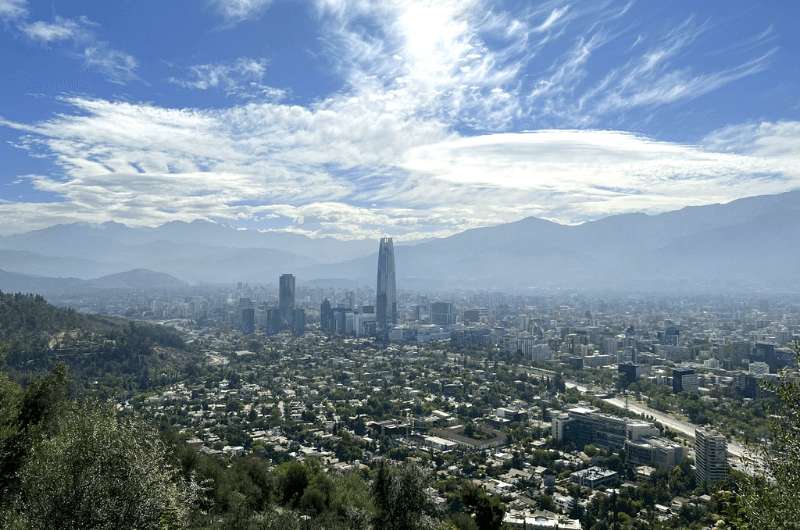
San Cristóbal Hill view
- Difficulty: Easy
- Distance: 9 km (5.6 mi)
- Trailhead: -33.415231, -70.617531
- Parking: there’s a parking lot about 600 m (2000 ft) down the road (or improvise since this hike starts in the city)
- Elevation gain: 246 m (807 ft)
- Time: 2.5 hours
Right in the heart of the Chilean capital lies San Cristóbal Hill. It’s more of a moderate walk up the street than an actual hike, but there are side-trails and paths that you can take when you’re sick of the road. A great option if you have a few hours to kill in Santiago.
What makes it unique
- San Cristóbal Hill sits right in the heart of Santiago, offering a birds-eye view of the city with the massive Andes Mountains as the backdrop.
- It’s more of a moderate urban walk than a rugged hike, but it’s incredibly rewarding—perfect if you only have a few hours to spare. Santiago site below you like on a golden platter.
- The hill has plenty of side trails, viewpoints, and even a cable car for those who want to save their legs for the way down.
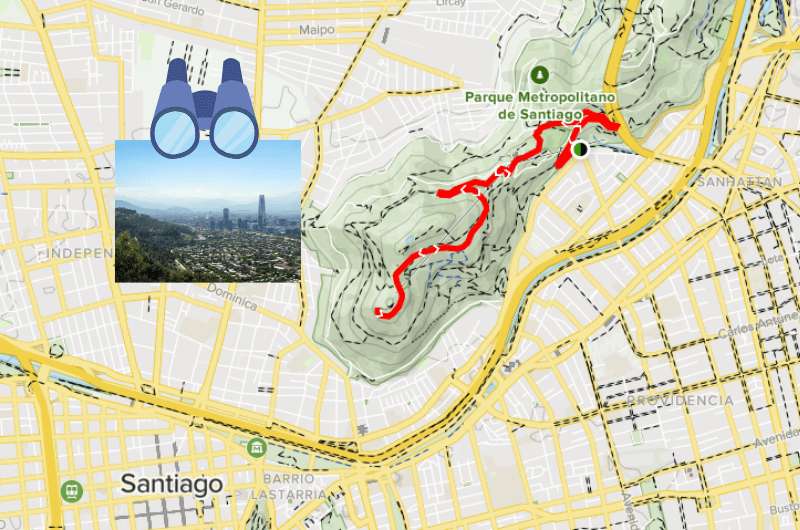
That is where the San Cristóbal Hill lies
What to expect on the trail
The hike up San Cristóbal Hill starts in Santiago’s streets, so don’t expect a wilderness trail here—it’s more like a steady walk up a well-paved road. The incline is mild but constant, and you’ll pass joggers, cyclists, and locals heading up on the way. Before you freak out—yes, there’s plenty of security, and we felt completely safe.
As you climb, you’ll spot side trails that snake off the main road—quieter paths where you can catch glimpses of the city peeking through the trees (and get some shade!). Some of them look like they need sprucing up and are quite overgrown, so pick ones that appear more tourist-friendly.
Reaching the top is where the effort pays off. The panoramic view of Santiago sprawled out below, backed by the towering Andes, is a real treat—especially on a clear day. There’s also a giant statue of the Virgin Mary up there.
For the way back, you can either retrace your steps or take the cable car down for a fun, relaxed finish.

14. Valparaíso City Circuit
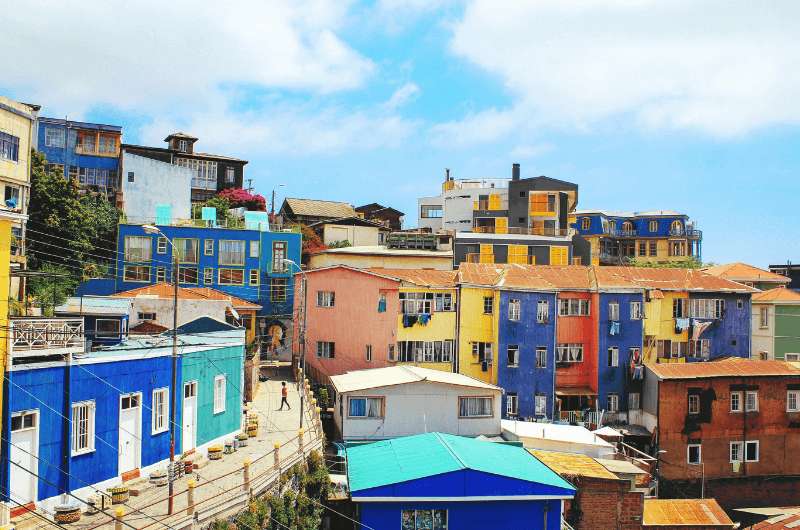
Valparaíso City
- Difficulty: Easy
- Distance: 5.8 km (3 mi)
- Trailhead: -33.048430, -71.622603
- Parking: park on the side of the road and off you go!
- Elevation gain: 181 m (594 ft)
- Time: 2 hours or more, depending on how much you linger looking at street art
The artistic, colorful Chilean version of San Francisco boasts many hidden gems in its streets worth discovering. There are many scenic spots on the way with perfect views of the city and the ocean. Take this Valparaíso City Loop hike to check all these cool places off your list.
Pro tip: Set off in the morning to avoid the tourist crowds!
What makes it unique
- Valparaíso is like a more chaotic, colorful San Francisco, with steep hills, endless staircases, and murals around every corner.
- This city loop is more of a wander with purpose than a traditional hike, leading you through quirky streets, hidden alleyways, and spots you’d miss if you weren’t on foot.
- The views are picture-perfect—bright houses stacked like Lego bricks, the ocean stretching out below, and street art so good (or at least plentiful) you’ll feel like you’re in an open-air museum.
What to expect on the trail
This “hike” starts off on the city’s lower streets, where it’s all noise, graffiti, and cafés. You’ll quickly start climbing—either up a maze of stairs that don’t always lead where you think or along steep, winding streets where cars honk like it’s their birthright. If you’re lucky, you might stumble on an old-school ascensor (cable car) to give your legs a break for a few pesos.
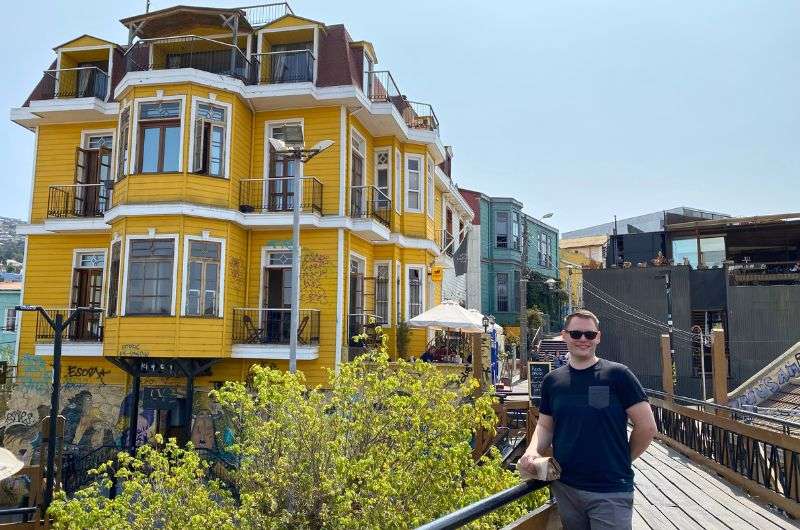
From natural landscapes we now move on to the picturesque and colourful Valaparaíso cityscape
As you climb, the city opens up, and you’ll hit the best bits—Cerro Alegre and Cerro Concepción. These hills are packed with some of the coolest street art you’ll ever see, including entire staircases painted like piano keys or rainbow stripes. Wander, stop at random viewpoints, and grab a coffee or a fresh juice from one of the tiny local vendors.
The higher you go, the better the views: colorful houses on the hillsides, boats in the harbor, and the ocean stretching below you.
Heading back down is when you’ll realize just how steep everything was on the way up. Your legs might complain, but the zigzagging streets and little murals you missed earlier will keep you entertained all the way back. Bring good shoes and cash for funiculars.
15. San Francisco Glacier
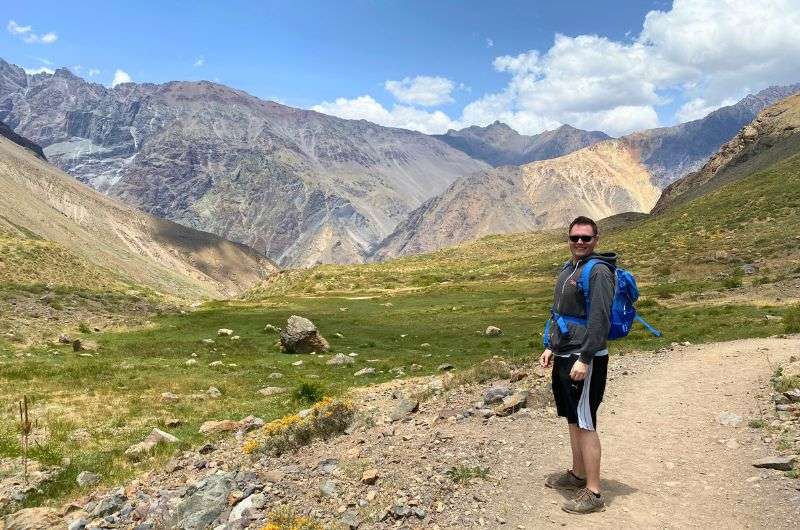
Hello, travellers! On my way to San Francisco Glacier
- Difficulty: Medium
- Distance: 15 km (9.4 mi)
- Trailhead: -33.48523, -70.03466
- Parking: park in the street where the trail starts
- Elevation gain: 669 m (2 293 ft)
- Time: 5 hours
This is my personal favorite hike near Santiago. The path will lead you to a lagoon near the San Francisco Glacier with epic views of the peaks along the way. It sounds much harder than it actually is!
Pro tip: Start early so you can have the trail mostly to yourself and still have time to grab a cold drink in Baños Morales before heading back to Santiago.
What makes it unique
- This trail combines an epic day hike with a scenic drive through the stunning El Maipo Canyon, just outside Santiago.
- The reward at the end is a gorgeous lagoon sitting right in front of the San Francisco Glacier, with massive peaks towering all around you.
- It’s a well-marked and maintained trail, so you can focus on the views without worrying about getting lost.
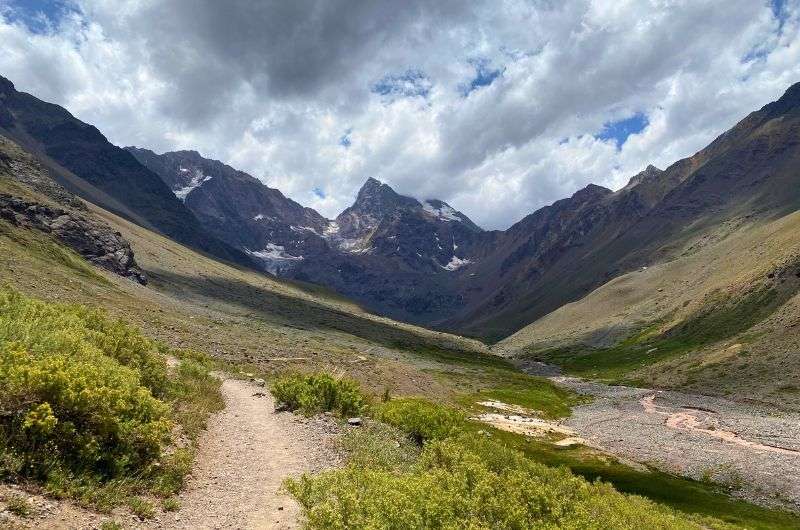
Towards El Maipo Canyon
What to expect on the trail
The adventure starts with the drive through El Maipo Canyon, which is worth the trip on its own. The road winds through dramatic cliffs and river views until you reach Baños Morales, a little village where the hike begins. There’s easy parking, so no stress about leaving your car.
The trail starts off with a steep climb that might make you question your fitness level, but it doesn’t last long. Once you’re past that, the path levels out and it’s a piece of cake. You’ll walk through wide open valleys with jaw-dropping views of snow-capped peaks on either side, and the silence is only broken by the occasional gust of wind.
When you finally reach the lagoon, it’s the kind of view that makes you stop and stare. Bring a snack and park yourself on a rock to soak it all in.
16. El Yeso Dam
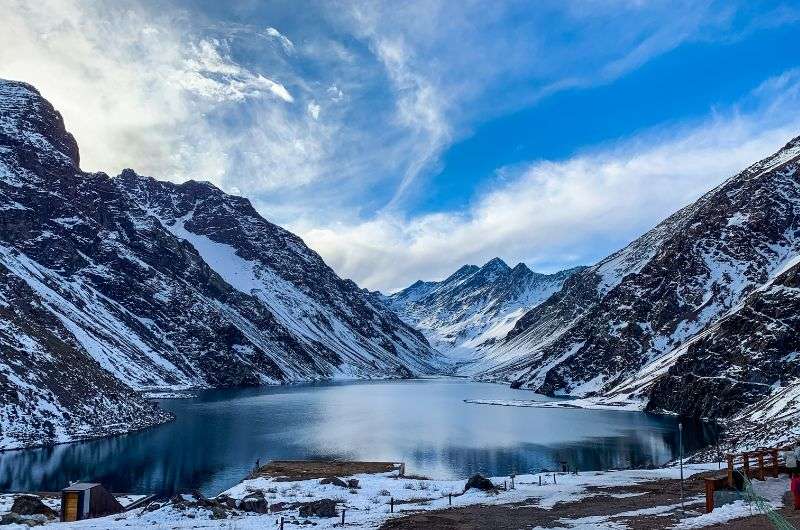
El Yeso!
- Difficulty: Easy
- Distance: Walk as long as you want by the lake
- Trailhead: -33.663620, -70.081934 (or anywhere else by the dam)
- Parking: you can turn left off the main road at the coordinates that I used as the starting point and leave your car there, or choose from several other spots that you will pass on the way
- Elevation gain: 0
- Time: 2–3 hours
Drive all the way up to El Yeso Dam and take a walk there along the lake. The setting is magnificent. It’s not a “hike” in the traditional sense, but a walk along the lake. The Andes mountain range surrounding the reservoir gives more punch to the atmosphere—it’s simply stunning. The drive though… can be interesting!
Pro tip: You can also hike to the neighboring Laguna Negra from El Yeso Dam. This trail lies off the beaten path, so you get a pretty big chance there will be no people there and you can enjoy a peaceful moment in the isolated wilderness.
What makes it unique
- El Yeso Dam isn’t about the dam itself—it’s the lake and the scenery that you’re there for. The water’s shades of turquoise, surrounded by rugged peaks, make this a perfect day trip from Santiago.
- You can even drive all the way to the far end of the lake where there’s a “beach”—just don’t expect to swim unless you enjoy freezing your limbs off.
- Getting there is part of the adventure, thanks to the dusty dirt road, narrow passages, and even some parts where you drive over water from the waterfalls.
What to expect on the trail
The drive to El Yeso Dam is where it all begins, and let’s just say it’s a mixed bag. From Santiago, it’s about 2 hours away. Then, you get to the dirt road near the dam—it’s narrow and full of clouds of dust kicked up by cars going to the same spot you’re going.
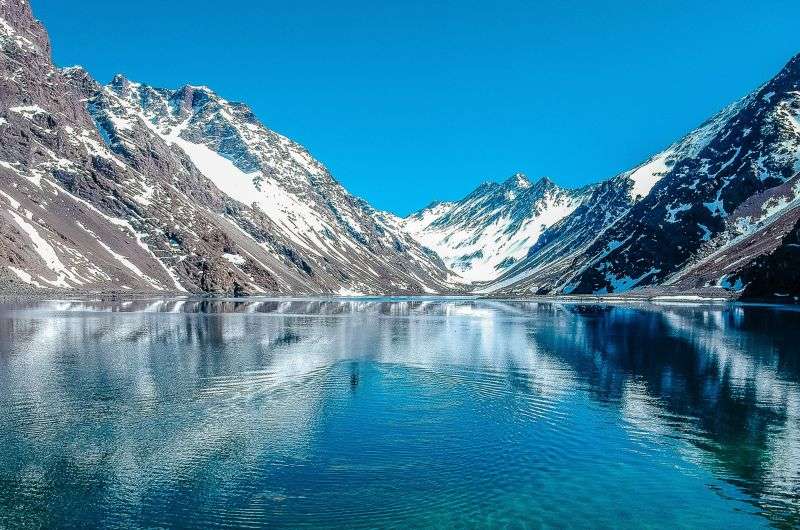
The lake and the scenery of El Yeso Dam
At a couple of points, you’ll even cross small streams fed by nearby waterfalls—don’t panic, you can make it in a sedan, no 4WD needed. Just take it slow and watch out for traffic jams when overconfident tourists try to squeeze past in the wrong spots.
Once you get there, the dam itself is… fine. It’s a dam. But look at the views of Laguna El Yeso—a massive lake surrounded by towering peaks, with water that’s a dark shade of turquoise.
If you keep following—in your car or on foot—the dirt road along the lake for 7 km (4.4 mi), you can head to the far end where there’s a little rocky beach. You won’t be swimming unless you enjoy ice baths, but it’s a peaceful place to relax and take in the views.
Bring snacks, but take your trash with you (I can’t believe this still needs to be said, but by the looks of things on the beach, some people still need to be reminded!), and avoid weekends if you don’t want to share the place with half of Santiago.
The best hikes in the Atacama Desert
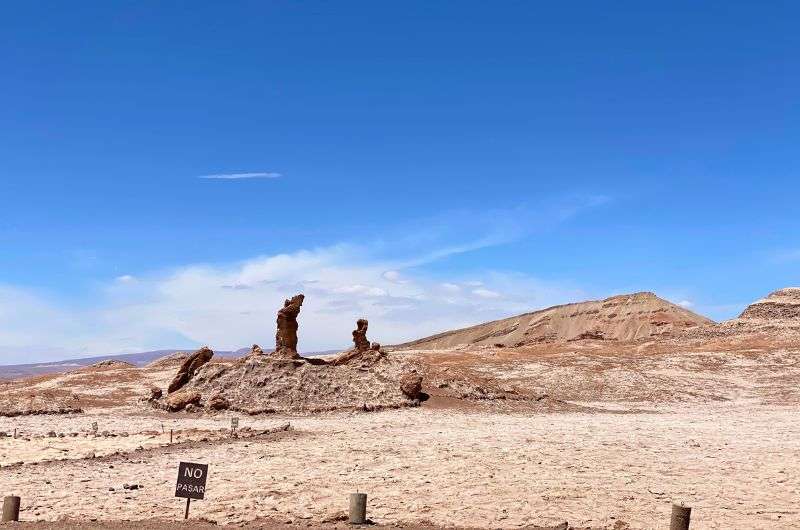
Hikes through the Atacama Desert, the driest place on Earth
The Atacama Desert may be the driest (non-polar) place on Earth, but that doesn’t mean that there are no good trails. Just hit the road early in the morning, or later in the afternoon, and take enough water.
Most trails start near San Pedro de Atacama, the gateway to the region’s natural wonders.
Pro tip: If you’re interested in more than just hiking, I’ve described a ton of other activities to do in San Pedro (the gateway to the Atacama Desert).
- Hotel recommendations: Hotel Pascual Andino
17. The Moon Valley Trail
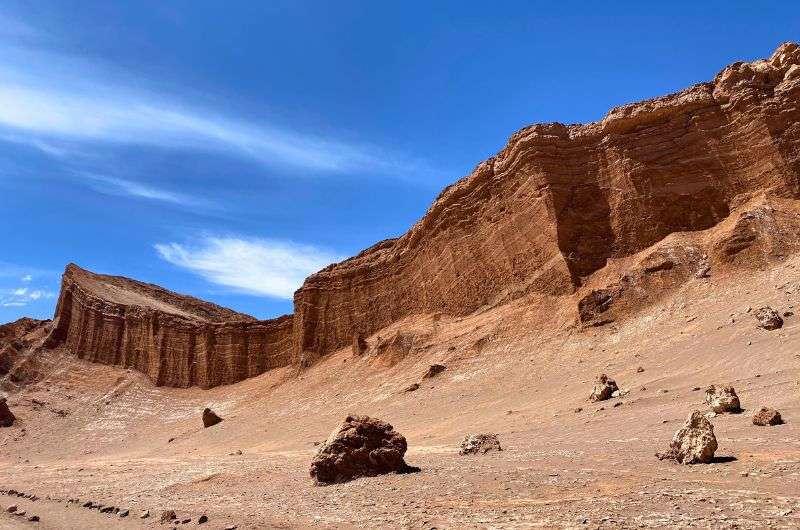
The Moon Valley Trail
- Difficulty: Hard
- Trailhead: -22.94746, -68.29273
- Parking: free at the Trailhead
- Distance: 20.5 km (12.7 mi)
- Elevation gain: 414 m (1 358 ft)
- Hiking time: 5-6 hours
Wondering what you can see in the desert? Well, just wait for it. The Valle de la Luna trek combines all the best spots in the valley.
What makes it unique:
- The landscape looks like something from another planet, with towering dunes and eroded rock formations that change color dramatically during sunrise or sunset.
- The dunes and rock formations are often tinged with pink, purple, and gold hues, especially at sunset, making for spectacular photo opportunities (and memories!).
- The silence of the desert amplifies the surreal experience, as there’s little to no vegetation or wildlife in this environment.
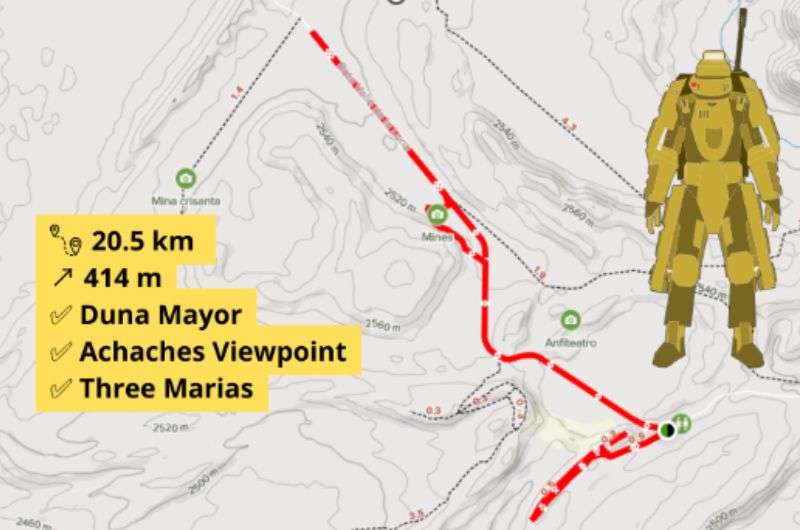
Moon Valley trail (map with details on Alltrails.com)
What to expect on the trail:
The Valle de la Luna trek starts with a wide, dusty path surrounded by jagged rock formations and salt-crusted ground that crunches with every step. The trail is well sign-posted. As you go deeper, the trail winds through narrow passages and towering dunes, and you might even pass a cave or two offering a bit of shade.
The best part? Climbing up to the ridges in the middle of the trail. The views are insane—sweeping desert landscapes with layers of color that shift as the sun moves. The final viewpoint is the cherry on top.
Heading back, the desert gets quiet and cool, and the trail feels like a whole new place in the twilight.
My tips
I strongly recommend planning your trip for the afternoon, so that you will be coming back as the sun goes down and get a chance to take some incredible photos. The majestic dunes and rock formations covered in all shades of pink, gold, and purple in the sunset is a jaw-dropping combination.
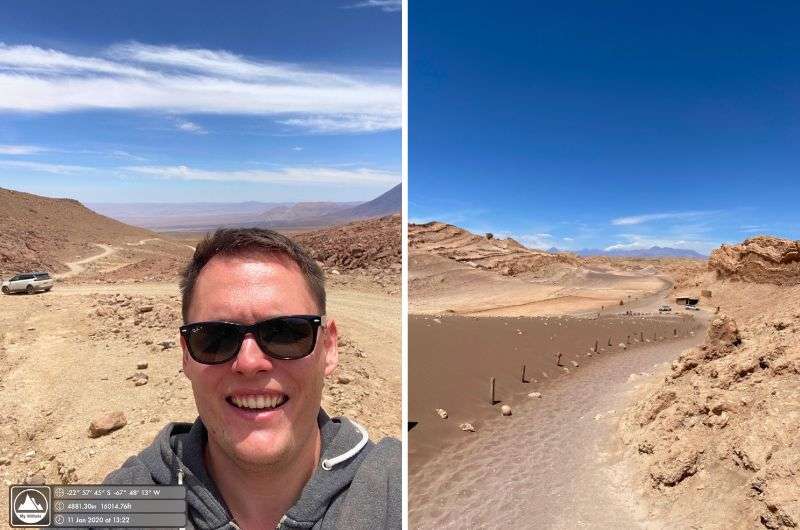
You can explore the desert also by car like I did
The evenings can be slightly chilly, which makes much better conditions for a walk than during the heat of midday.
Tip: If you’re not up for the full trek, Valle de la Luna can also be explored by car or bike, with several viewpoints and shorter walking paths for less strenuous exploration.
18. Pukará de Quitor—Devil’s Throat
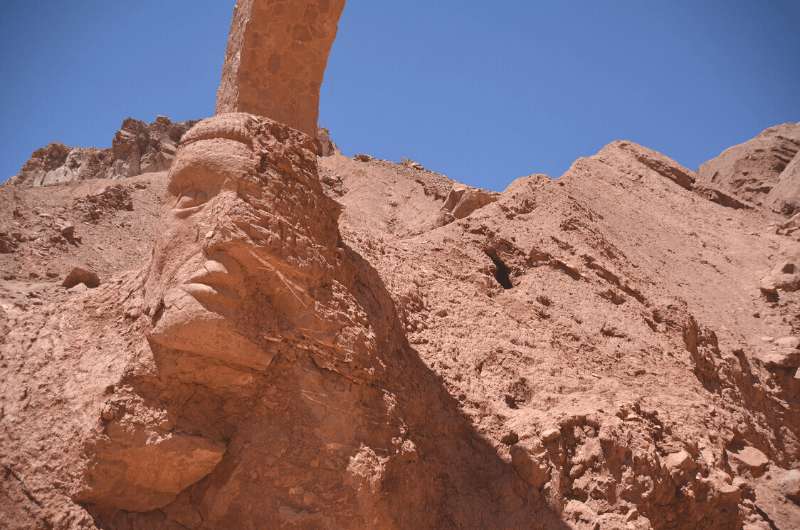
Devil’s Throat
- Difficulty: Hard
- Distance: 21 km (13 mi)
- Trailhead: -22.910691, -68.200443
- Parking: There are free public parking spots 200 m (650 ft) from the starting point
- Elevation gain: 381 m (1 250 ft)
- Hiking time: 6 hours
The Devil’s Throat is an amazing hike with zero shade, so bring a hat and lots of water!
This nice hike starts at the edge of San Pedro. It walks you around Mars Valley, the Pukará de Quitor ancient fortress, and off to the Devil’s Throat Viewpoint. Most of the way winds along the San Pedro River canyon, but there’s no shade, so remember to bring enough water and a hat. You can also rent a bike or cut it back and do only Pukará de Quitor and Mars Valley version.
What makes it unique
- This hike takes you through a blend of history and natural beauty, starting with the Pukará de Quitor, a pre-Columbian fortress that dates back over 700 years.
- You’ll follow the path along the San Pedro River canyon, with striking views of Mars-like landscapes and rugged cliffs.
- The trail ends at the dramatic Devil’s Throat Viewpoint, offering sweeping views of the canyon and the surrounding desert—a sight that feels both eerie and majestic. And windy!
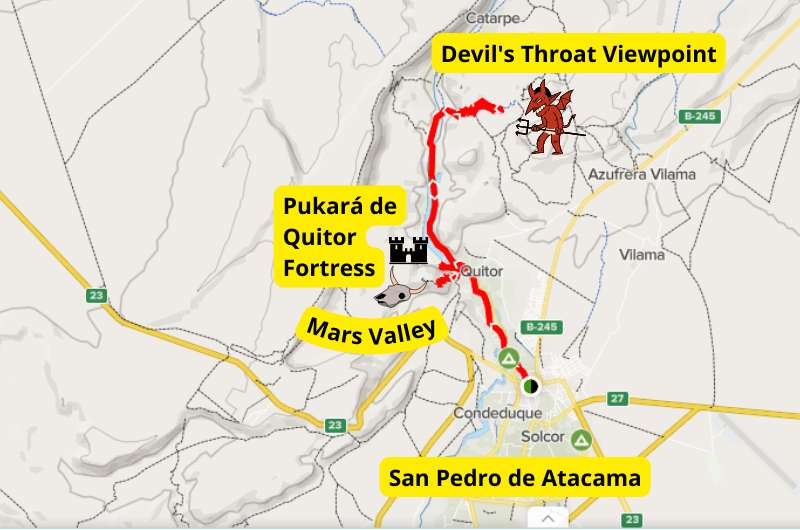
This is how you get to the Devil's Throat. If you dare to go there...
What to expect on the trail
The trail starts right on the edge of San Pedro, so no long drives or planning needed to get going. The first stretch takes you through the Pukará de Quitor ruins, where you can climb up ancient walls and picture what life might have been like for the people defending this fortress centuries ago.
From there, the path runs alongside the San Pedro River canyon, with red rock formations on one side and the river snaking quietly below on the other.
As you get closer to Devil’s Throat, the terrain becomes steeper and rougher, with loose rocks that can get a little annoying as they try to throw you off balance. The narrow canyon opens up dramatically at the viewpoint, and so besides stunning views, you also get strong winds!
On the way back, the shadows grow long over the canyon, and the golden light transforms the rocks once again—a perfect end to the hike.
19. Cerro Toco Trek
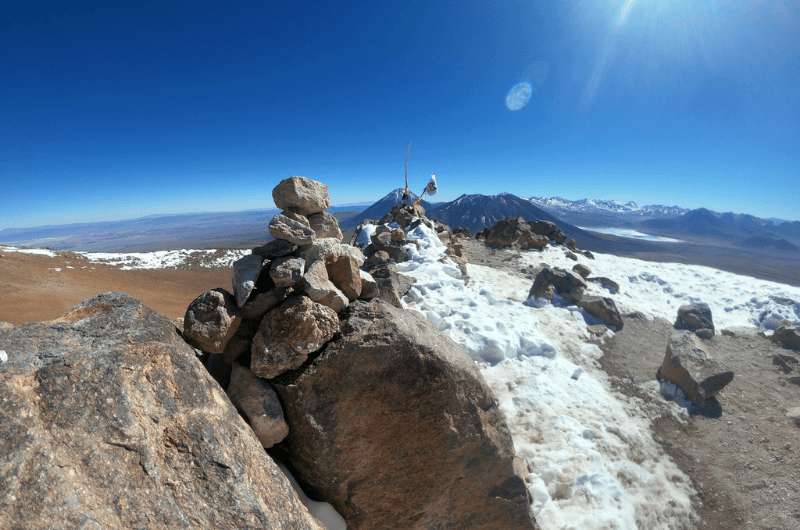
Cerro Toco Trek
- Difficulty: Hard
- Distance: 4 km (2.5 mi)
- Trailhead: -22.955963, -67.777188
- Parking: you can leave your car at the trailhead, but it better be a 4WD or you might have a hard time making it all the way there
- Elevation gain: 306 m (1,003 ft)
- Time: 2 hours
The trek to Cerro Toco Peak is quite demanding despite it being short because of the high altitude.
Pro tip: If you’re planning on going on this hike, prior acclimation to the high altitude is essential to prevent mountain sickness! And I mean at least a week, anything less than that is not enough and you will want to go home early.
All you need to know about mountain sickness is covered in the article The Big 3 of Altitude Sickness. Besides that, this trek is well marked, and you can enjoy cool views of the desert from the snow-capped peak.
What makes it unique
- This trek isn’t just about the trail—it’s about the altitude. Starting at 5,200 m (17,060 ft), it’s one of the highest hikes you can do in the Atacama Desert.
- Cerro Toco is an extinct volcano, and its peak offers breathtaking panoramic views of the surrounding desert, salt flats, and even Bolivia in the distance.
- The short distance makes it accessible for adventurous hikers, but the thin air and potential altitude sickness keep it challenging.
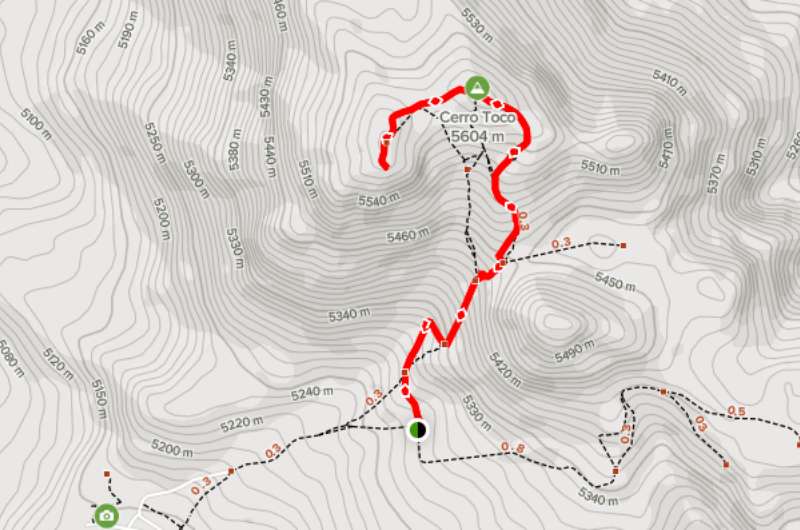
Trek to Cerro Toco Peak
What to expect on the trail
The hike to Cerro Toco starts with a drive up to the trailhead, which itself is an adventure—expect a rough road that’s best tackled with a 4WD vehicle.
Once you’re out of the car, the altitude hits almost immediately. The trail begins as a steady incline over rocky, barren terrain. The air feels crisp and dry, and you’ll find yourself taking more breaks than usual just to catch your breath. Luckily, the trail is well-marked.
About halfway through, the incline gets steeper, and every step feels like a mini victory. The landscape is stunning, with patches of snow even in warmer months. Reaching the summit is the ultimate reward—uninterrupted views of the Atacama Desert below, framed by other volcanic peaks.
On the way back, the descent feels much easier, and you’ll probably notice how quiet and still the surroundings are, broken only by the sound of your hiking boots on the volcanic gravel. It's a short hike, but it’ll stay with you long after you’re done.
20. Puritama Hot Springs and Puritama River Canyon
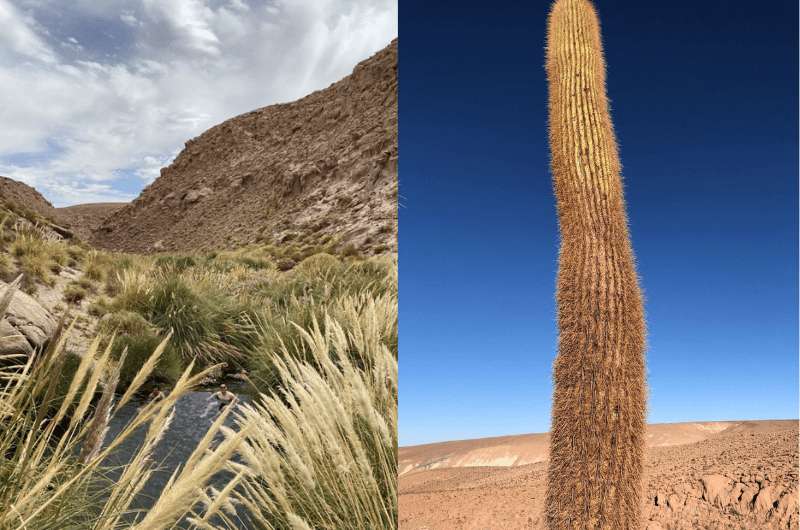
Puritama Hot Springs
- Difficulty: Easy
- Distance: 10 km (6.2 mi)
- Trailhead: -22.749690, -68.071283
- Parking: leave your car by the side of the road at the starting point
- Elevation gain: 365 m (1 197 ft)
- Time: 3 hours
Walk along the Puritama River Canyon, one of the few places in the Atacama Desert rich with flowers, cacti, and other plants. This hike is relatively easy and the path is surrounded by marvelous landscape. If you’re ready you can even jump in one of the hot springs pools (prior reservation needed). This hike is suitable also for families or less fit hikers.
The hike through Puritama River Canyon to the Puritama Hot Springs is refreshing, because plants actually grow here for a change. Then there’s the bonus of being able to soak in hot springs at the end.
What makes it unique
- This hike takes you through the Puritama River Canyon, one of the rare green areas in the Atacama Desert, teeming with flowers, cacti, and other plants—a refreshing contrast to the desert's arid landscapes.
- The trail leads to the Puritama Hot Springs, where you can relax in naturally heated pools (just be sure to reserve in advance).
- It’s a relatively easy hike, making it ideal for families, beginners, or anyone looking for a more laid-back adventure.
What to expect on the trail
The hike begins on a gentle path winding alongside the Puritama River, with the sound of running water accompanying you—a rare treat in the Atacama. The canyon walls rise on either side, and as you walk, you’ll spot patches of vibrant greenery, wildflowers, and cacti. You’ll learn to appreciate plant life really fast in the desert!
About halfway through, the scenery becomes more dramatic, with sections of the trail narrowing as the canyon deepens. The path easy to follow, but the changing views make it anything but boring.
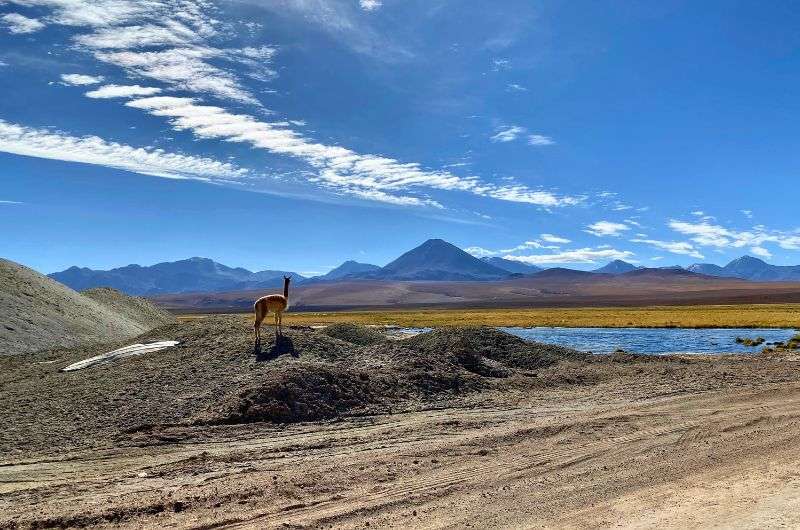
Now let’s relax. We deserve it
When you reach the hot springs, it feels like stumbling into an oasis. The pools are tucked right into the canyon and surrounded by lush vegetation. If you’ve planned ahead with a reservation, you can soak in the warm waters—perfect for easing tired legs after the hike.
The return trip follows the same path, but the light shifting in the canyon creates a whole new perspective. Ok, it’s not entirely different, but that’s what you get when the path isn’t a loop.
Sometimes, all you need to do is take the first step... I've filtered out the best hotels in Chile for you
Save it for yourself to come back to later, or share with your friends on social media!
I've already planned your ititnerary for the trip, complete with my travel tips.
You might also be interested in reading:
- 3 Weeks in Chile: The Ultimate Travel Itinerary
- All You Need to Know About Traveling to Chile: 15 Tips and Tricks
- All You Need to Know About Climbing Villarrica in 4 Steps
- 8 Highlights from my Visit to Patagonia
This post contains affiliate links. I earn a small commission if you make bookings through my links, at no additional cost to you. Thank you for your support!
These are the top hiking trails in Chile, South America
Overview of Chile's hiking regions: From glacial lakes in Patagonia to trekking in the desert
My top tips for hiking in Chile:
What to pack for hiking in Chile
Top trekking tours across Chile's diverse regions
Hiking in Torres del Paine National Park, Chile (Patagonia hiking)
2. Mirador Base Las Torres Hike
5. Camp Grey—John Gardner Bridge Trek
Trekking in Pucón and Lake District
6. Villarrica Volcano Trek (Villarrica National Park)
7. Sendero Sierra Nevada Trek (Conguillío National Park)
8. Huerquehue Lakes Trail (Huerquehue National Park)
9. Sendero Los Alerces Loop Trail (Vicente Perez Rosales National Park)
10. Petrohué Waterfalls (Vicente Perez Rosales National Park)
11. Hike to Sargazo Lagoon (Allerce Andino National Park)
12. Salto Río Chaicas (Allerce Andino National Park)
Hiking and trekking in Santiago
The best hikes in the Atacama Desert




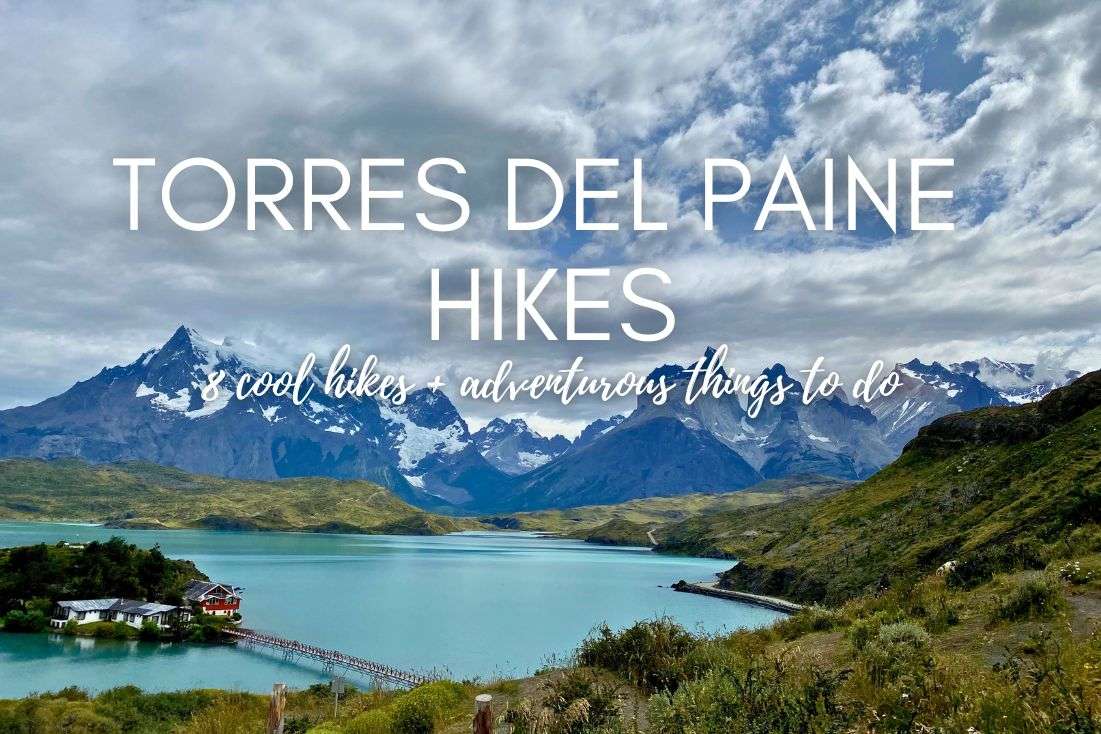

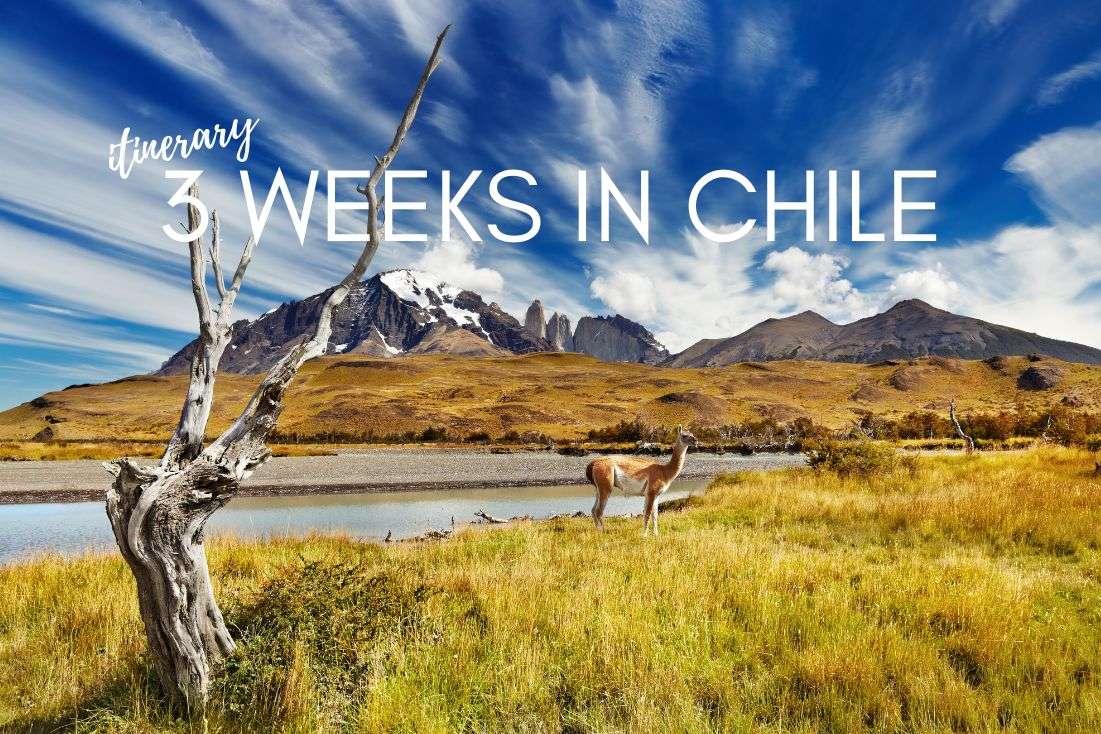



Comments | Thoughts? Give us a shout!